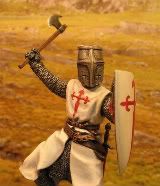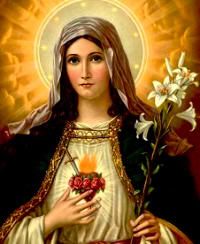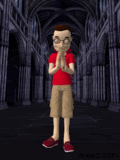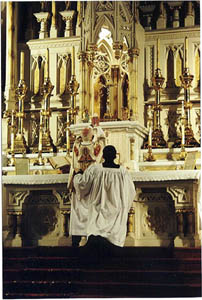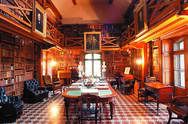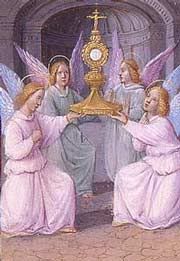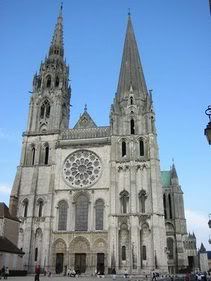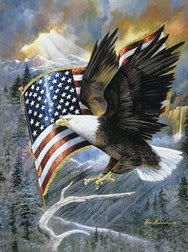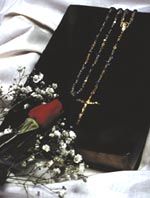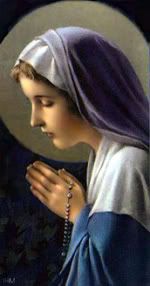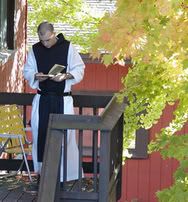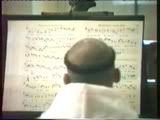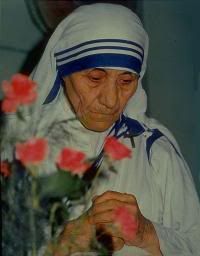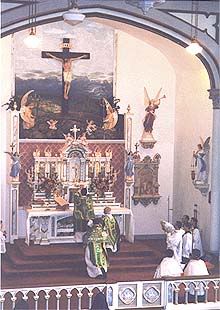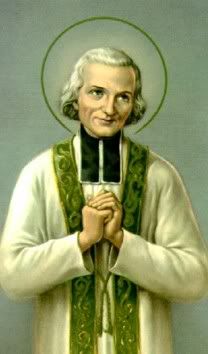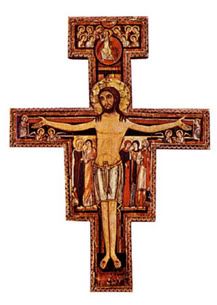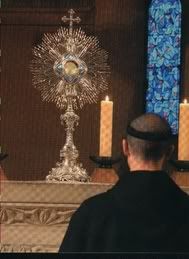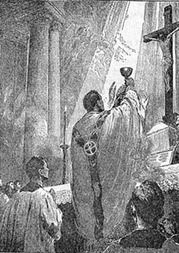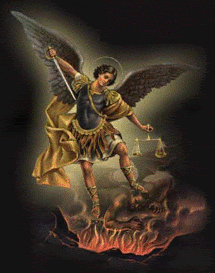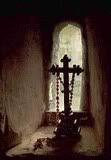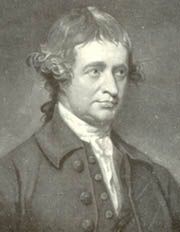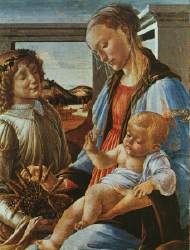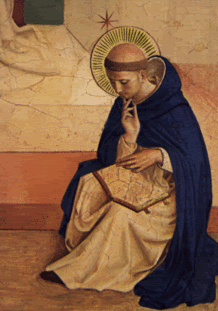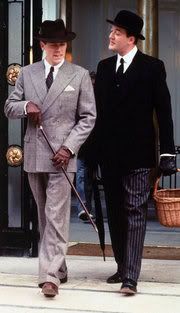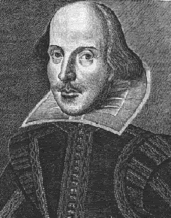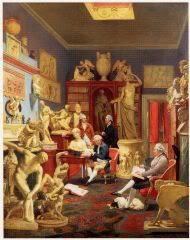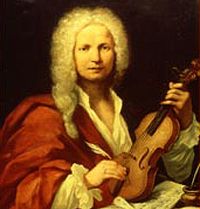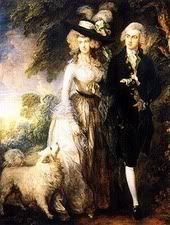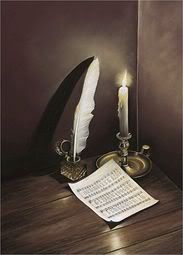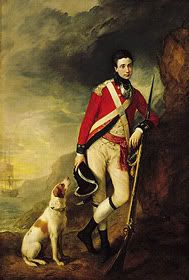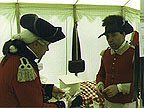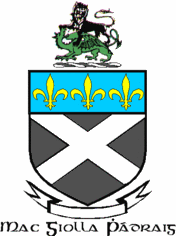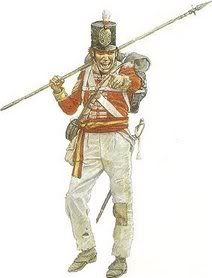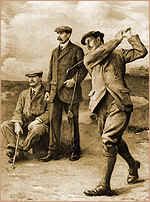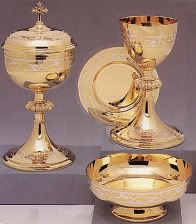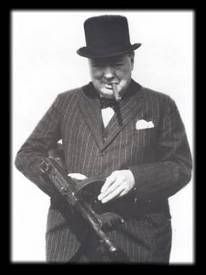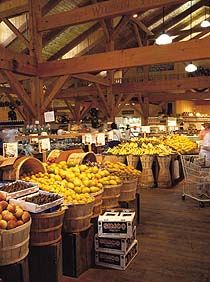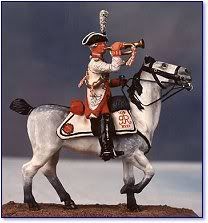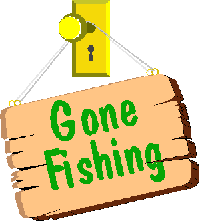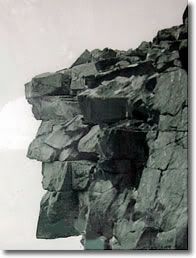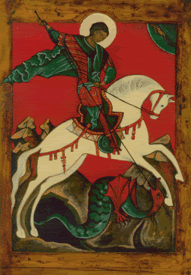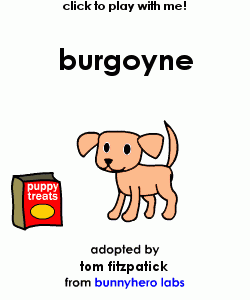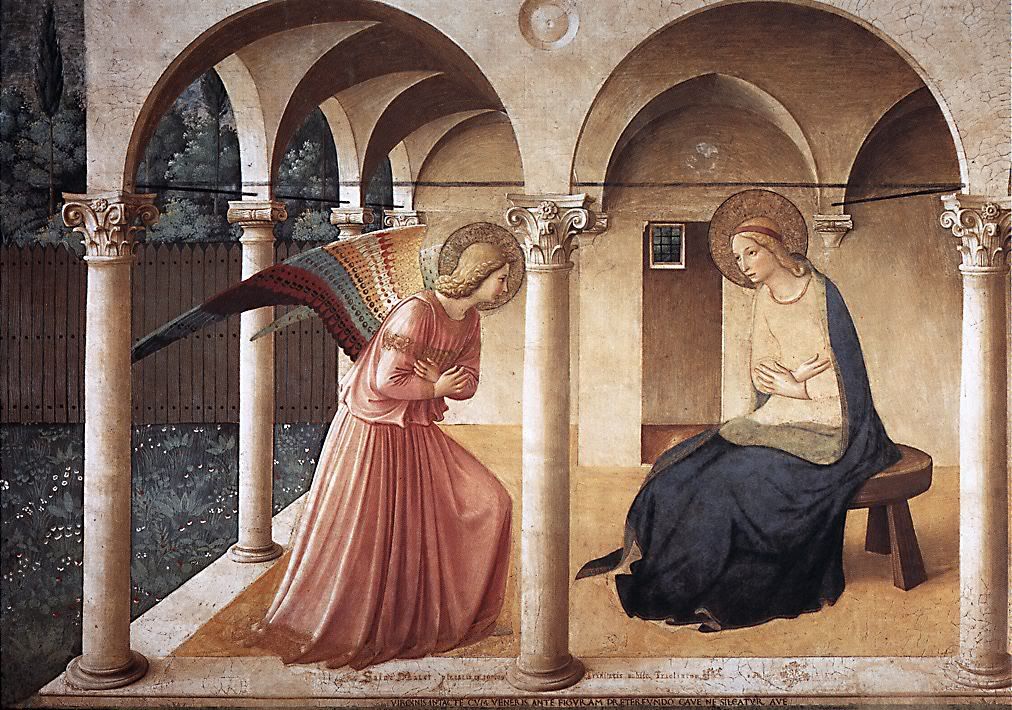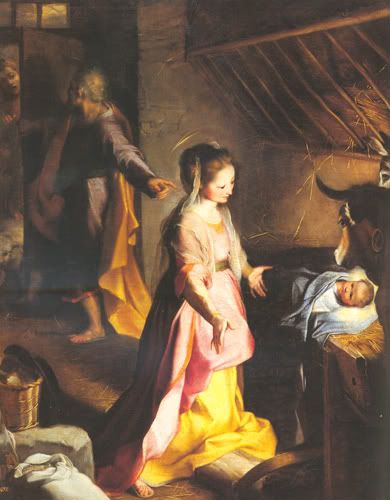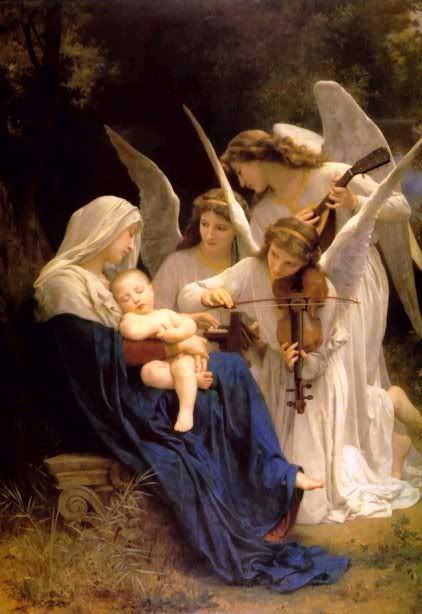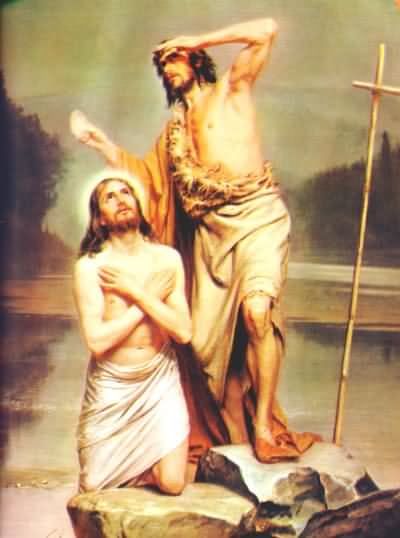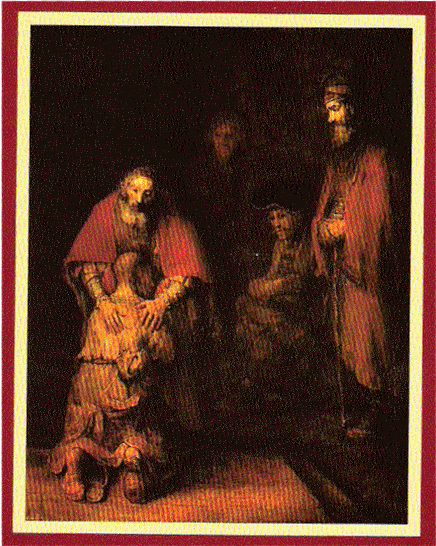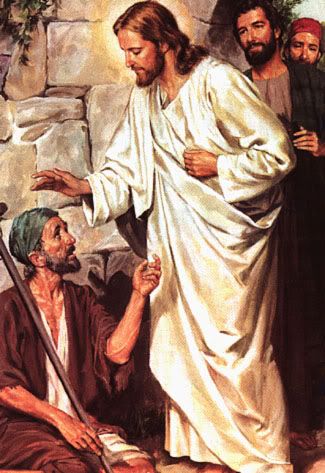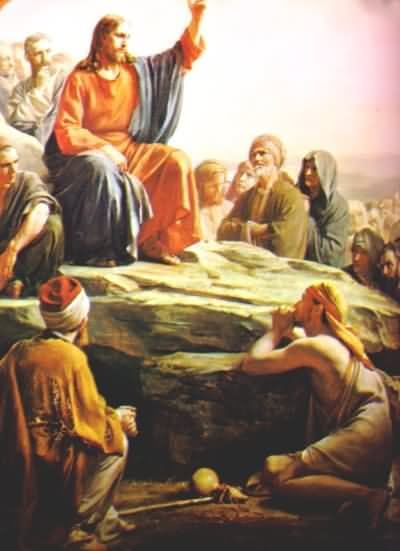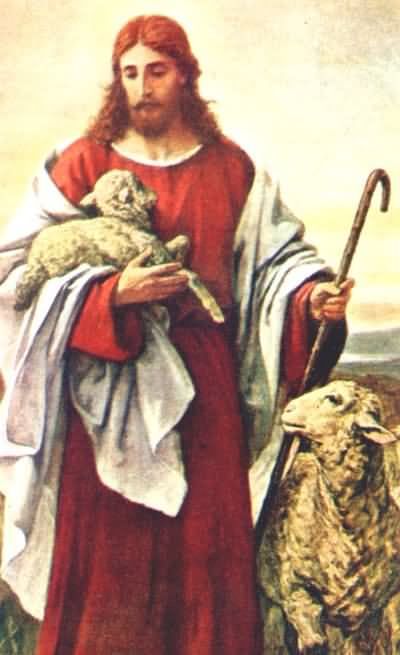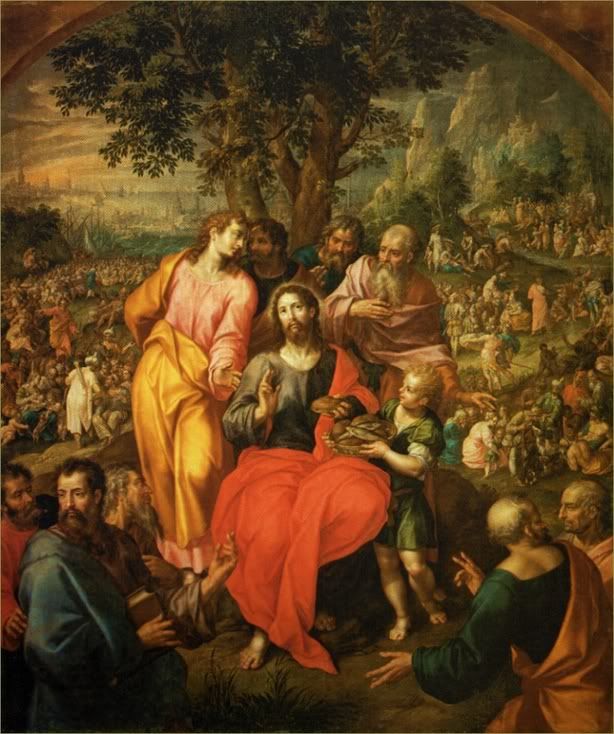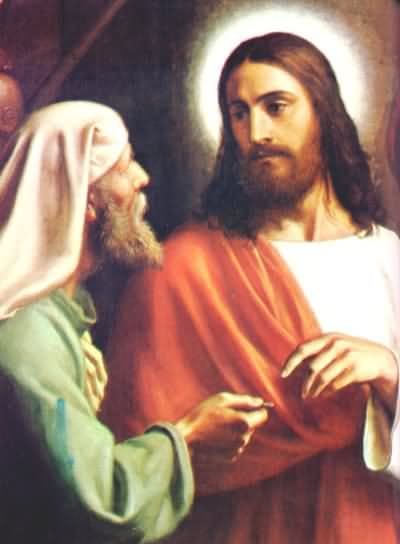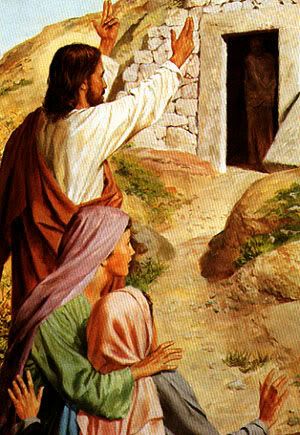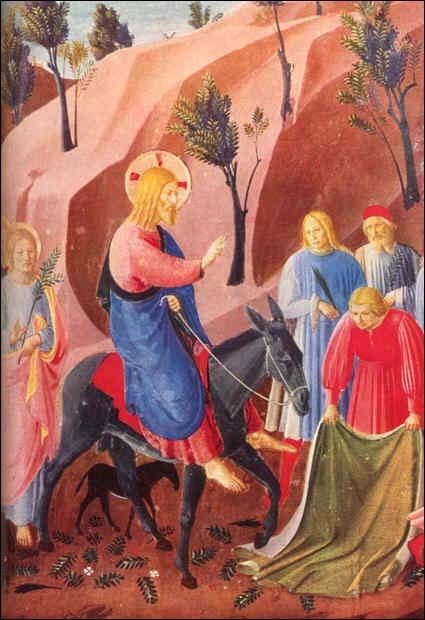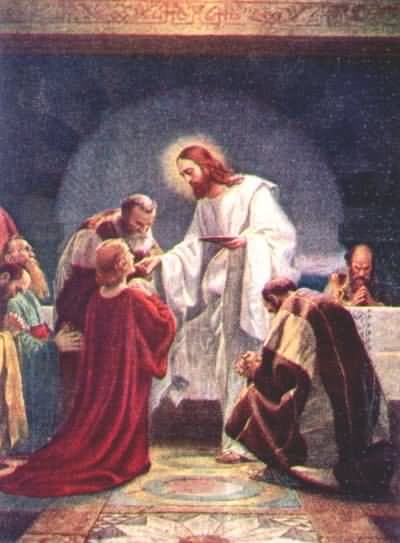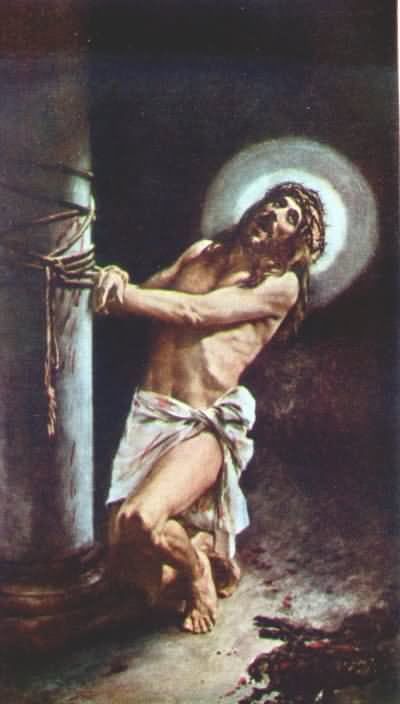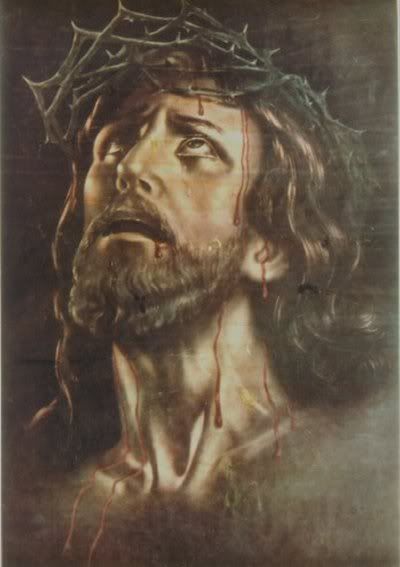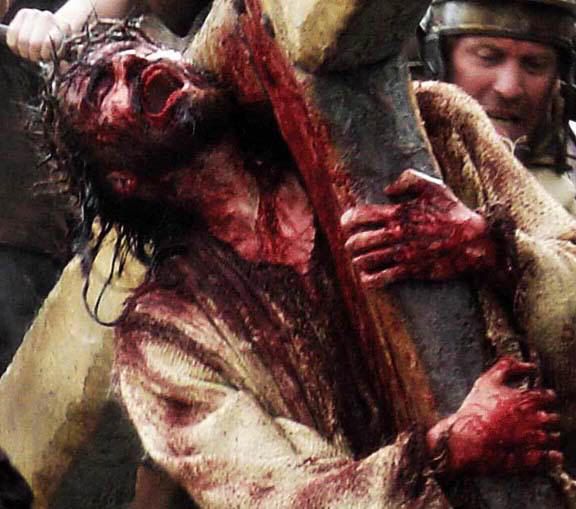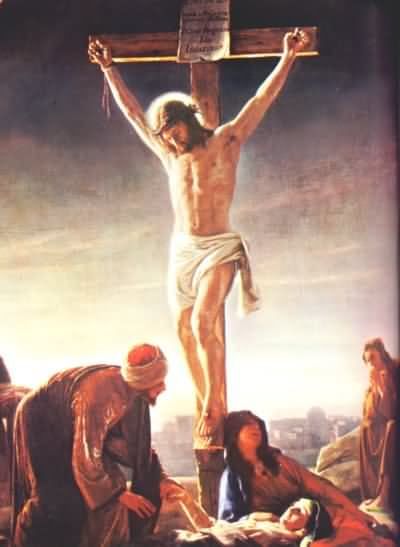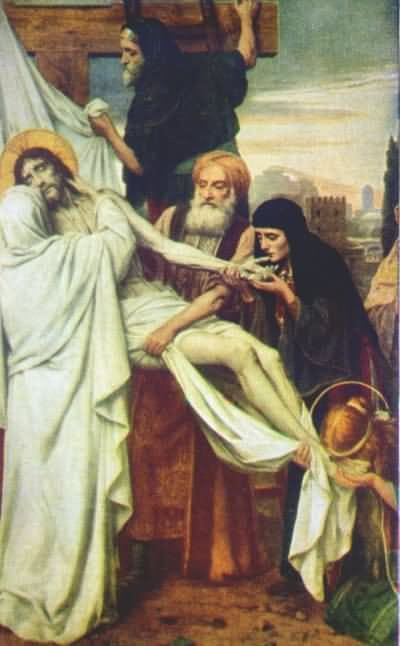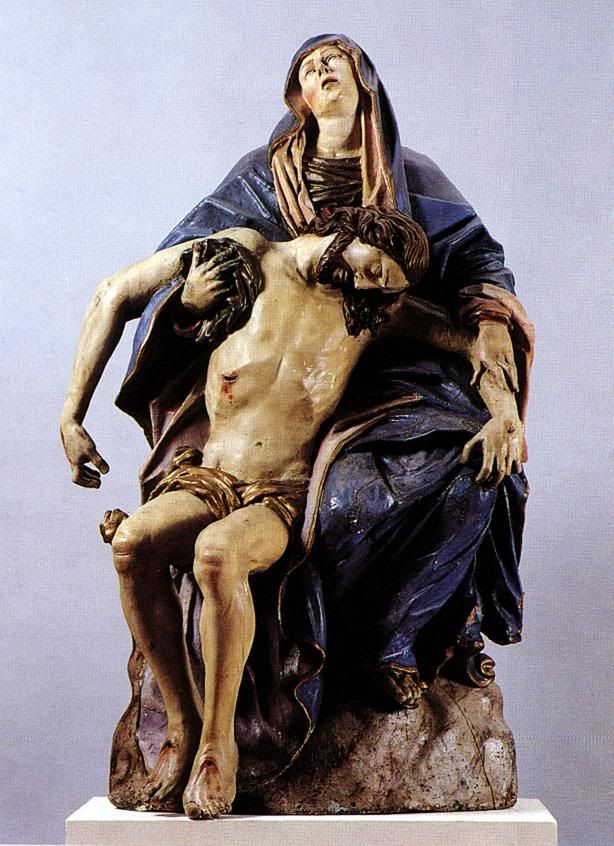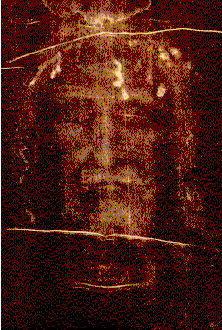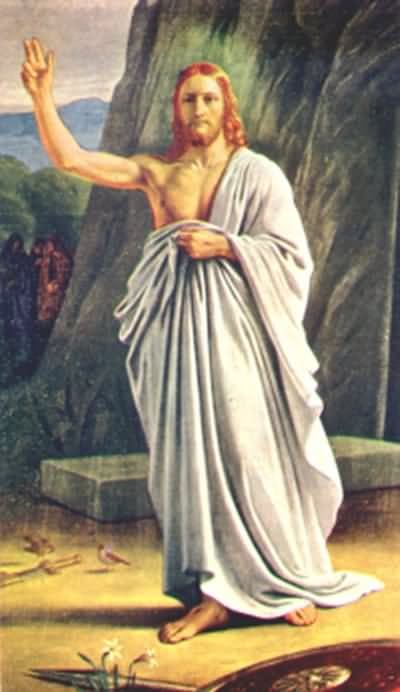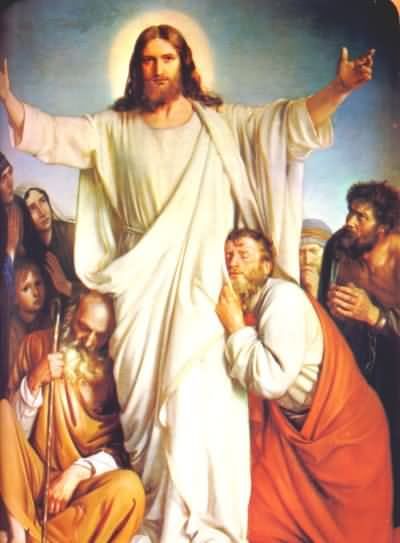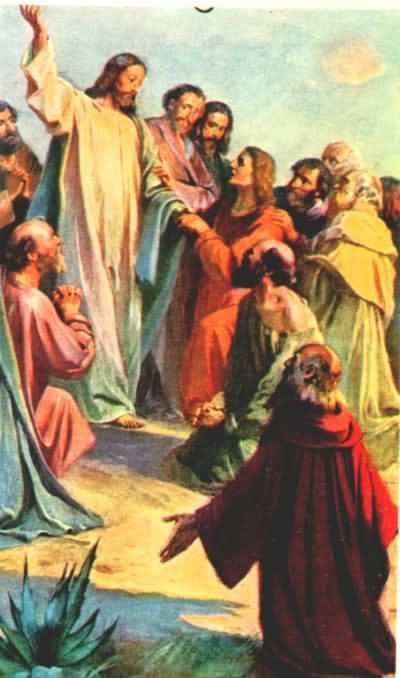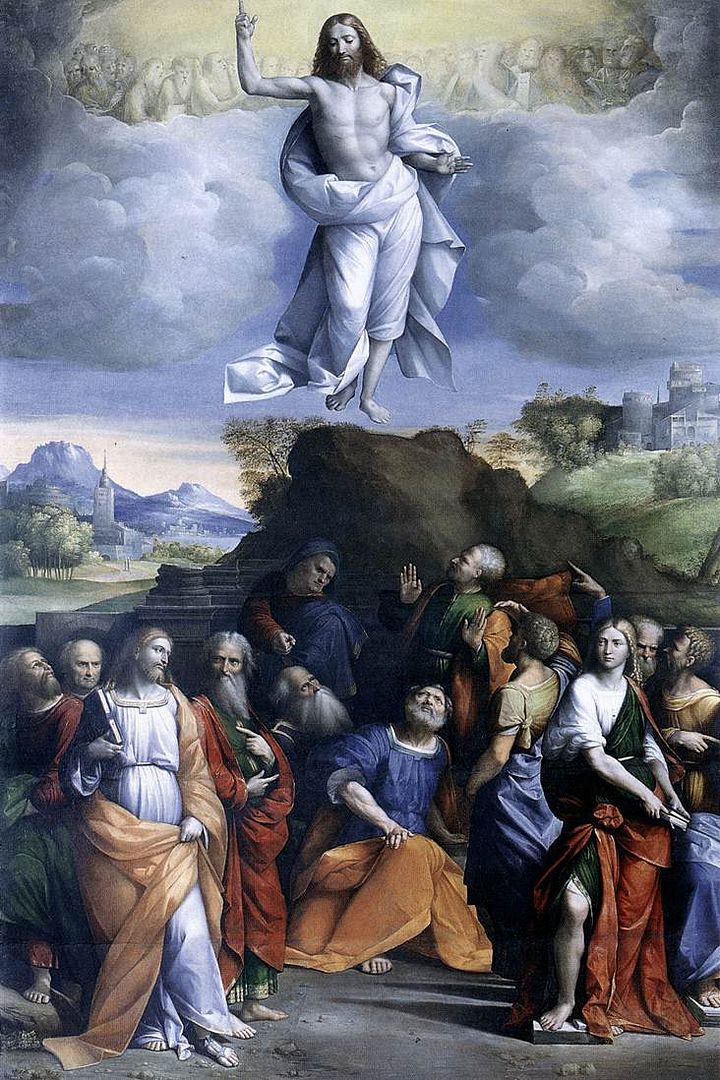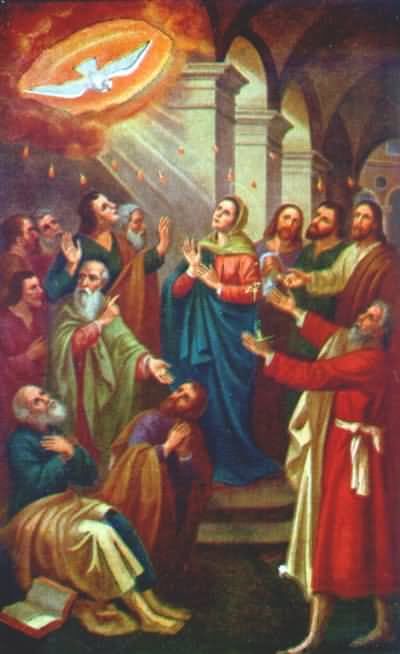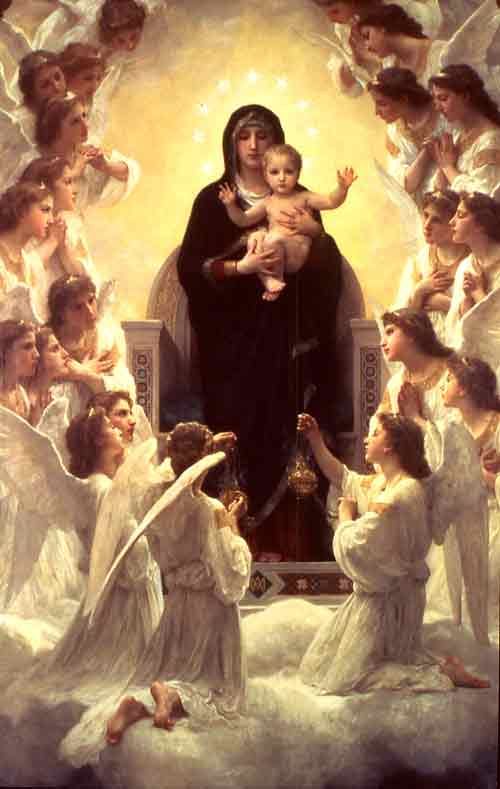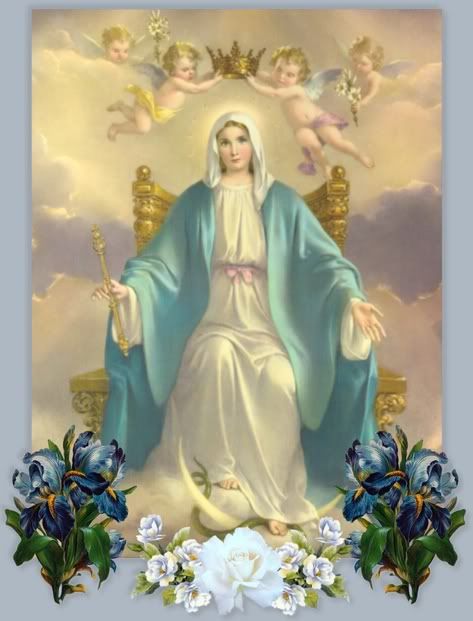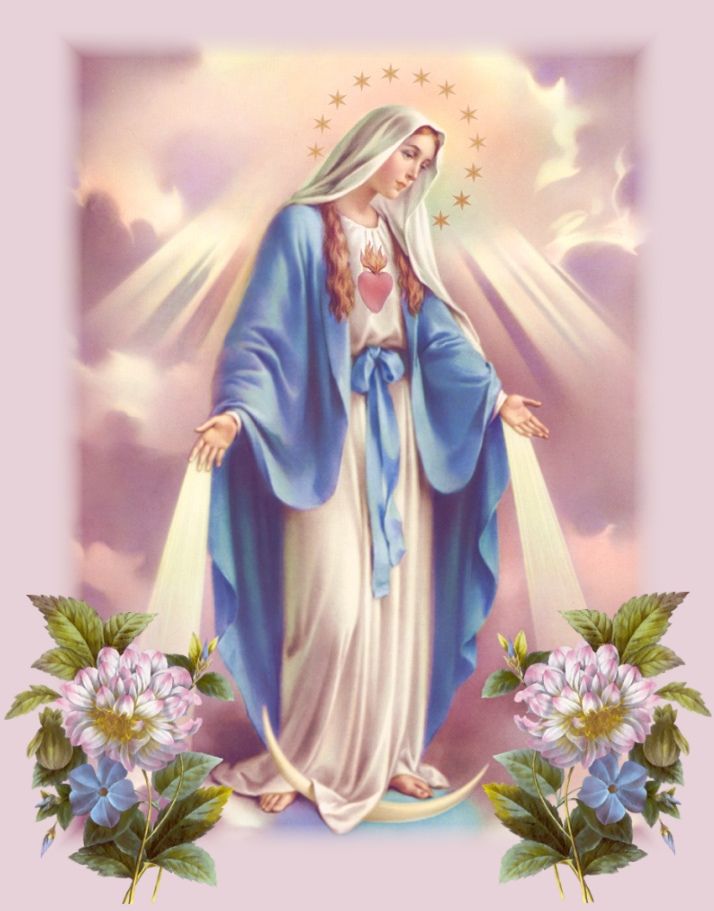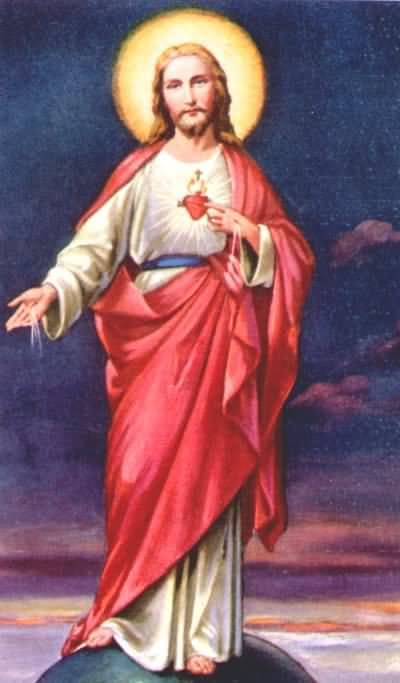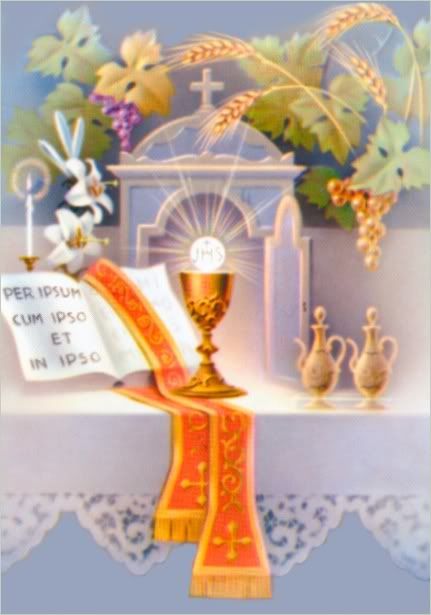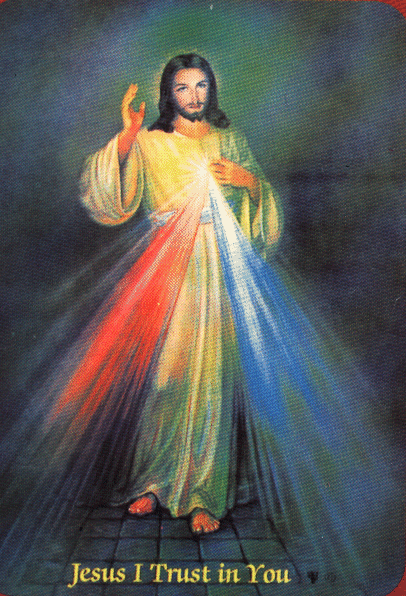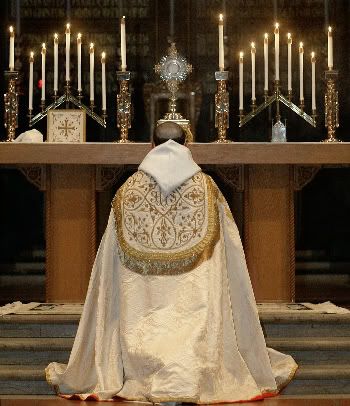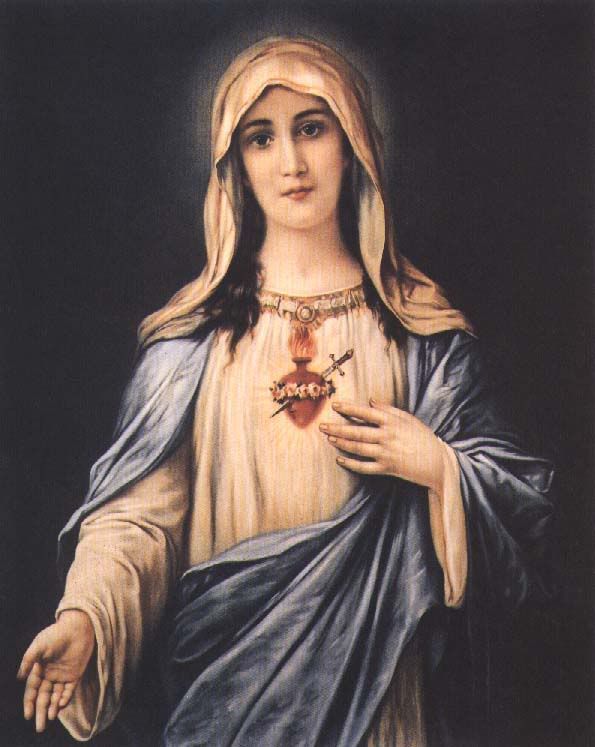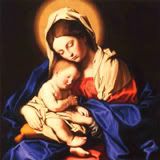Thursday, April 19, 2007
Images of the Battle Road
For those not familiar with the term, "Battle Road" is the stretch of highway between Concord and Boston along which Lt. Col. Francis Smith, Maj. John Pitcairn, and, after Lexington, Brig. Gen. Hugh, Earl Percy returned to Boston on the afternoon of April 19, 1775 under heavy fire from up to 5,000 Massachusetts militia.
The best preserved, and restored, section of the Battle Road is the stretch of (mostly) Route 2A or Massachusetts Avenue from Route 128 in Lexington to Meriam's Corner in Concord, which is part of the National Park Service's Minutemen National Historical Park. this portion of the battlefield has been under the care of the national park service since the 1950s, and the long-term master plan of restoring the entire stretch to its 1775 appearance is beginning to show. East of Route 128, through Lexington, Arlington (then called Menotomy), Cambridge, Somerville, and Charlestown, most of the original flavor of the area has been lost to dense commercial and residential development. The loss of the historic nature of that part of the battlefield, where some of the heaviest fighting took place, is probably irreversible, since restoring that part of the battlefield to the way it looked in 1775 (as has been done, is being done, in the National Park) would probably cost more than the Big Dig. Even finishing restoring the Park's section of Battle Road to its 1775 appearance will involve re-routing part of Route 2A, and that spells expensive nightmare.
Col. Smith and his command of about 700 elite grenadiers and light infantry from all ten regiments of the Boston garrison left Concord for Boston about noon on April 19th after searching Concord for rebel munitions and stores with decidely unspectacular results.
Within a half hour, the first shots of the return march were fired at Meriam's Corner. No doubt who fired first here. British light infantry skirmishers felt that the large group of rebels from the morning fight at the bridge, and also from towns of northern Middlesex county were too close to the column of grenadiers on the road, and let loose an ineffective fire on them. The fire was returned with some casualties, and the running fight on the road to Boston was on. Smith's column continued on, stretched out over almost a half-mile of road, with light infantry skrimishers on each flank trying to keep rebel snipers out of range of the column. After Meriam's Corner, there were sharp engagements at Hardy's Hill, at the Bloody Curves (that stretch of road used to called "The Bloody Angle", but that term is being abandoned by historians a) because of confusion with a Civil War battle site of the same name, and, b) because there is, in fact, more than one angle or curve in the road there), along the Virginia Road, among the boulders north of Nelson Road, at Parker's Revenge, at the Bluff, and at Fiske Hill. All along this stretch of about 5 miles, British ammunition dwindled, while rebel numbers soared as companies of militia and minutemen from 3-4 counties poured onto the battlefield after early AM musters and hurried marches.
By the time the elite flank companies under Smith and Pitcairn crossed the present roadbed of what is now Route 128, and crested Concord Hill, the greatest disorder prevailed. Both Smith and Pitcairn had been targets for rebel marksmen, and Smith was wounded in the leg, while Pitcairn had lost his horse and was shaken up in the fall. Ammunition was nearly exhausted. The light infantry flankers could no longer keep up with the pace of the column on the road, and had largely been driven back to the road themselves. And the men, who had been marching with little rest since 2AM, often at a very fast pace, and with little in the way or rations or water, were exhausted, demoralized, and without strong leadership above company level.
As the redcoated column got to the top of Concord Hill in Lexington, they were much relieved to see, on the other side of present Lexington Center, the four battalions of the First Brigade under Lord Percy (4th, 23rd, 47th Regiments of Foot plus a battalion of Marines) drawn up with artillery support (two 6-pounder cannon). The two forces met up in the vicinity of Monroe Tavern, bringing total British strength to about 1,600. After a pause, they resumed the march, with Percy's fresh troops protecting the exhausted and ammunition-less flank companies.
But more and more rebel militia poured onto the field. The heaviest fighting of the day occurred on the Lexington/Menotomy line, in the area then called Foot of the Rocks, and now known as Arlington Heights. The high ground to the south of the Battle Road was the prize, since some of it dominated parts of the road. Percy's strong flank protection bulled the way through, but at high cost.
The battle raged through Arlington Center to the Jason Russell House, where militia from Danvers and Lynn suffered the heaviest rebel losses of the day. In the Russell House vicinity alone, 12 militiamen were killed. The redcoats suffered corresponding losses. The fighting continued. Every so often, Percy would unleash his artillery when he felt the rebels drawing too close to his column.
At Watson's Corner in Cambridge, Percy pushed through a rebel effort to force him to use the overland route he had marched out on, over the Great Bridge near the Harvard campus, whose planks had been taken up and the whole area heavily invested with militia. Taking that route would have been a deathtrap, and probably bogged the entire column down in a stand-up battle with militia 5 times their strength, and would have forced them to rebuild the bridge before crossing, all the while under fire.
Instead, Percy bashed through the group of rebels trying to force him to use the other disasterous road, and took the road through part of what is now Somerville, past the old Schraft's Candy building, across Charlestown Neck onto the Charlestown Peninsula, finally coming to a rest atop Bunker Hill with the guns of the British fleet preventing rebels from crossing the narrow Charlestown Neck after him. His troops were then ferried in boats back to Boston from Charlestown. Abandoning the heights of Charlestown, of course, left the door open for the next showdown with the rebels, 2 months later at Breed's Hill.
That was the fighting along the Battle Road in a nutshell. Notice that the two prior engagements on Lexington Green at about 5am, and the skirmish at the North Bridge in Concord at 10am are not considered part of the Battle Road story. They were preludes to it. To get a flavor of the fighting, though it is in no way a serious study of the engagement, or historically accurate in any sense other than providing a sampling of what it was like, I recommend viewing the Hallmark Hall of Fame presentation April Morning, based on the novel by Howard Fast. For a made-for-TV movie, it has an excellent cast: Robert Urich, Tommy Lee Jones, Rip Torn, Chad Lowe, Meredith Salenger, and Susan Blakely. The Battle of Lexington Green scene was filmed by re-enactors from the 10th, 23rd, and 64th Regiments of Foot. Unfortunately, it is not available on DVD, only on VHS.
For a much more historically accurate presentation, with the feel of an old-time radio play, I strongly recommend the cassette Battle Road by the Colonial Radio Theater, featuring the talents of many then-members of the 10th Regiment of Foot.
OK, on to the images.

Boston and environs, 1775, showing the necessity of marching overland across the narrow Boston Neck, or being rowed across to the Cambridge or Charlestown shore. In fact, Smith's expedition landed in the area labelled on the map, "Phipp's Farm."
Map of the Battle Road as it traverses Minuteman National Historical Park Not including the prtions of the battlefield in East Lexington, Arlington, or Cambridge, all to east of the map area.

Lt. Col. Francis Smith of the 10th Regiment of Foot, the commander of the British march, given the job because he was the senior Lt. Col. in the garrison. Criticized for being slow-moving, he actually kept his troops mving at a very rapid pace, as the reached Lexington 3 hours after starting the in the marshes of East Cambridge (near the site of the original Lechmere store). This portrait was painted in Ireland, where the 10th Foot had spent many years, c. 1765, before the changes dictated by the Royal Clothing Warrant of 1768 were made official and implemented.
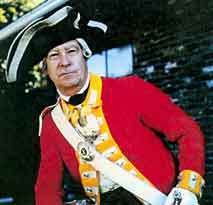
The uniform Lt. Col. Smith would have been wearing in 1775, as he was portrayed by Vincent J.R. Kehoe, founder and commander of the 10th Regiment of Foot. What is different from the 1760s portrait? The hat is of a different style. The coat now has a collar. The cuffs are in a different style. The sash is no longer worn over the shoulder, but around the waist. The waistcoat is now white (wool or linen, depending on the season) not red. The edges of the facings (lapels) and the pockets are no longer trimmed in metallic lace. And that metallic lace is different. It would appear that the lace in the 1760s portrait is gold. The 1768 Warrant specified silver as the "officer's colour" of the 10th. So the gorget, buttonhole and hat lace, buttons and all metal work are now silver. As regimentals were only worn on formal occasions, an unlaced frock coat sufficing for most daily work, including long marches and any actual combat, Col. Smith would have had to either buy a whole new coat, or have his old regimental significantly and expensively altered by a tailor to conform to the new Warrant's specifications. And British officers did not receive any clothing allowance from the British government. They were expected to pay for all their uniforms and equipment out of their own pocket, on a pay scale that could best be described as miserly. As the Gentleman Johnny Burgoyne character in The Devil's Disciple said, "Madam, if you only knew how much I paid for my commissions, and how very little I am paid, you would think much better of me."

Long thought to be Major John Pitcairn, Marines, British second in command, but actually his son, who also reached the rank of Major. The style of the collar tells us that this was painted in the 1780s or 1790s. If it is any consolation, he was said to strongly resemble his father.
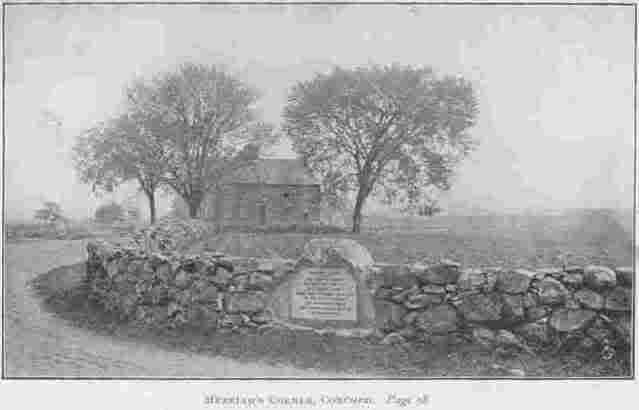
An old view of Meriam's Corner, and the Meriam Farmhouse, where the fighting started as Smith's troops marched back to Boston. This corner was an important crossroads, and troops from northern Middlesex County entered the fight here.
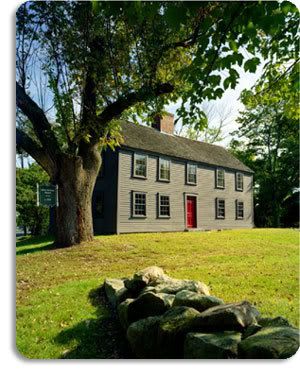
The Meriam Farmhouse today
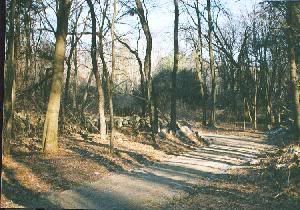
Part of the Bloody Curves, where the road makes a series of 90 degree angles, with trees coming right down to the road (at least today, land use surveys say that in 1775, there were apple orchards over part of the terrain).

4th (King's Own) Regiment light infantryman trying to flush out rebel snipers in the area of the road known as the Bloody Curves.
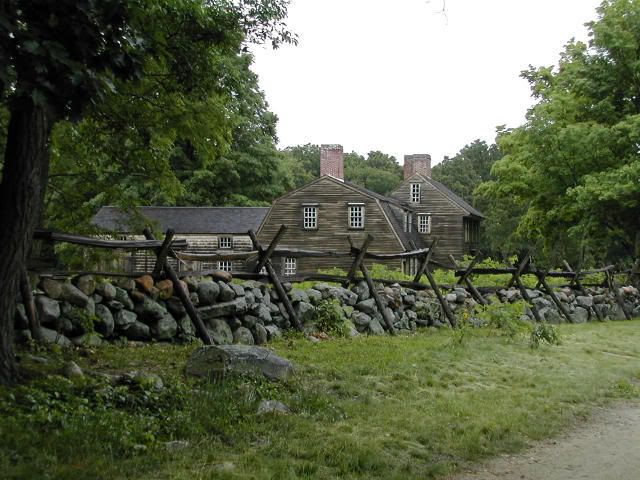
The area around the Hartwell Tavern is probably the most heavily photographed part of the Battle Road, because it has been restored to its 1775 appearance.
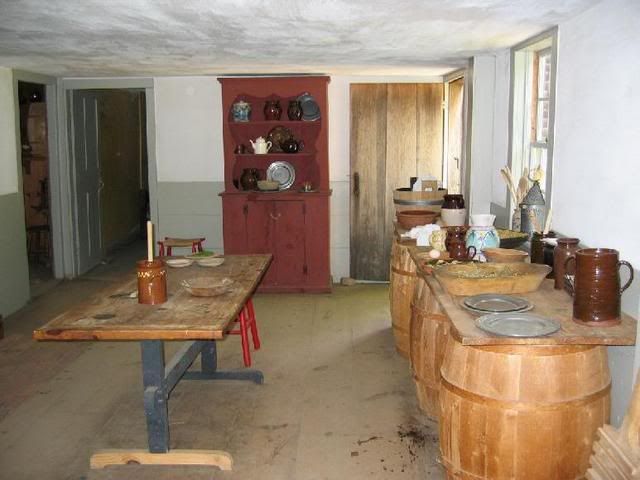
Inside the Hartwell Tavern
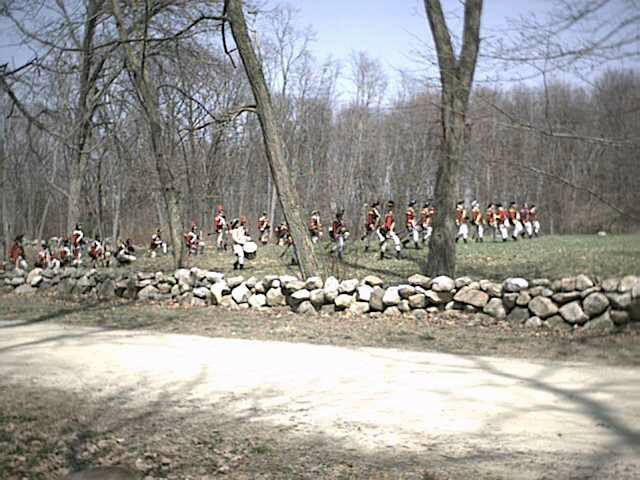
British light infantry deploying near the Hartwell Tavern in the 225th anniversary reenactment
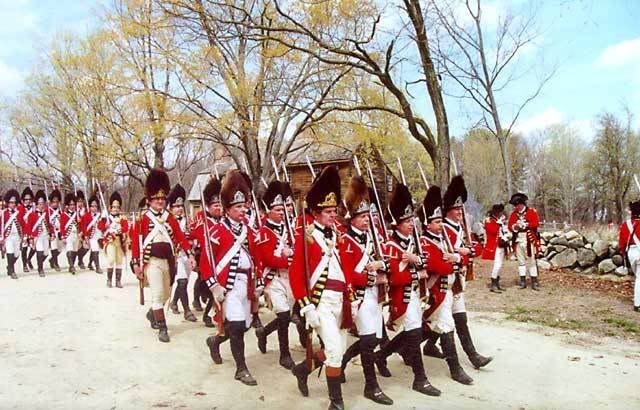
The 23rd Regiment of Foot (Royal Welch Fusiliers) marching past the Hartwell Tavern
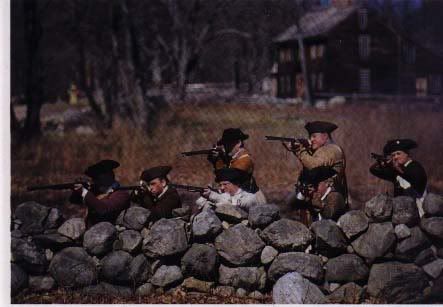
As the British column passed a point, rebel snipers moved in
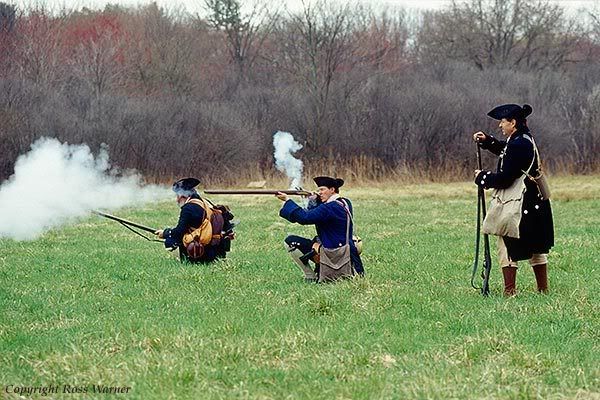
The idea that the rebel minutemen came out to fight in waistcoats and shirtsleeves, perpetuated by the "uniforms" adopted by many recreated minutemen companies in the 1960s and 1970s, is ludicrous. The day was breezy and cool, in the 50s, and was sandwiched between two rainy periods. They wore coats, and were equipped with at least rudimentary provisions for a few days in the field.

After the Hartwell Tavern comes the Hartwell House. It burned in the 1950s, and all that is left is the chimney, framed in in the 1980s.
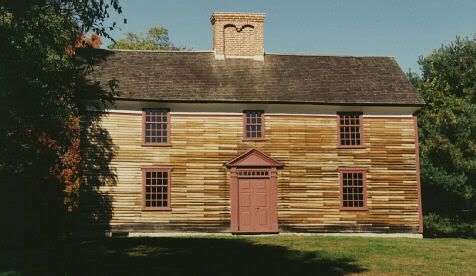
The Captain William Smith House ought to get more recognition that it does. William Smith was the younger brother of Abigail Adams, and the captain of Lincoln's minute company. Smith got word from Doctor Prescott after his escape from Major Mitchell's patrol, of the redcoat expedition, and got his company to Concord almost before the Concord militia itself had assembled.

Dean Ryan of Boston College, an old friend (we have killed one another many times) with the Smith House in the background

Moving along, you pass the Paul Revere Capture site, and the road curves to the north, up what is called Nelson Road. The fields to the north of road here feature large boulders, which were used as cover by several of the militia, including William Thornton, who might have picked off two soldiers in this part of the road. That would be an unusual feat of marksmanship, since it is estimated that only 1 in every 300 rebel musketballs fired at the British column found a mark.

Parker's Revenge is another place that ought to be better known. Captain John Parker of lexington rallied his command, battered in the early AM engagement on lexington Green, and brought them to this wooded rise commanding the road just after it leaves Lincoln and re-enters Lexington. It was most likely in the skirmish at this site that Lt. Col. Smith was wounded in the leg.
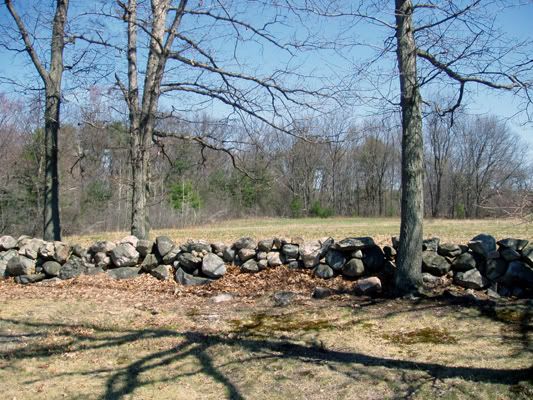
After the road passes the site of Parker's Revenge, it curves back to the south, and then makes a sharp, almost hairpin turn around a steep bluff. Major Pitcairn took his large companies of marine light infantry and grenadiers, and whatever other companies were still in decent shape, and tried to hold that bluff while the column got itself back into order on the road leading up Fiske Hill. His men were driven from the bluff, and the confusion on the road increased.
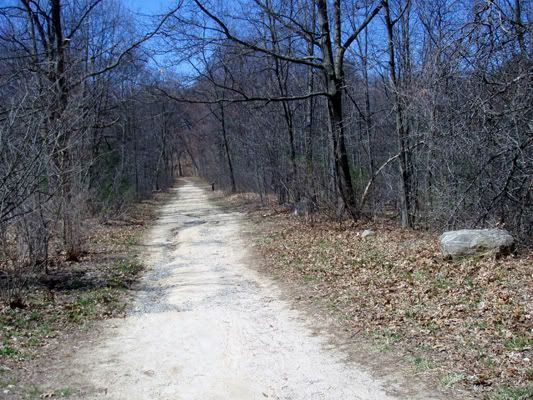
At Fiske Hill, new rebel troops began peppering the column, along with those who had been in the fight since Concord Bridge and Meriam's Corner. On the eastern side of Fiske Hill was the Fiske farm, where James Hayward of Acton and a British grenadier killed each other as they tried to draw water from a well.

Once the British climbed Concord Hill, they could see their rescuers from the 1st Brigade drawn up on the other side of Lexington. OK, this is actually the 23rd Foot at Yorktown last year, but you get the idea.

The column stopped for a rest at the Monroe Tavern in East Lexington. Monroe, the orderly serjeant of Captain Parker's company was otherwise occupied at the time, and I am sure the exhausted soldiers made free with his supplies of drink. Here, soldiers of the 22nd Foot, with 10th Foot grenadiers in the background, take a break during the 1997 reenactment of Battle Road.
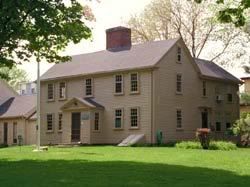
There is precious little else I can show you that will not look like congested city streets. Yet, the heaviest fighting, and the bloodiest, took place in Menotomy, which we now call Arlington. The Jason Russell House near Arlington Center was the scene of the worst fighting of the day, with 12 militia from Danvers and Lynn killed.
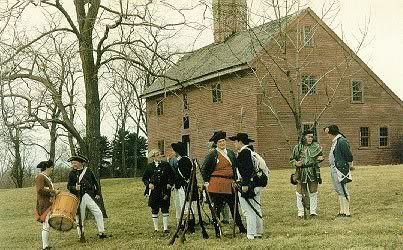
Troops from Essex County, like the Danvers militia depicted here (at the Rebecca Nurse House) took part in the fighting from this point on, along with troops from Middlesex, Norfolk, Suffolk, and Worcester Counties.
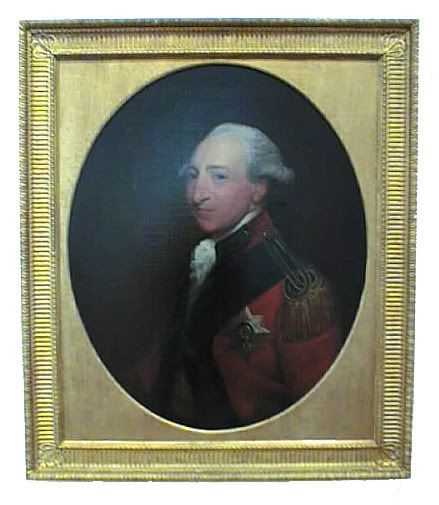
It was due to the judgment of Lord Percy, commander of the First Brigade, that the British column got back to Boston, battered, but in one piece. As the son of the Duke of Northumberland, and a solidly professional soldier in his own right, he held additional high command in the next two years, including at Fort Washington, and the capture of Newport, Rhode Island. But he was disgruntled with the leadership of Gage, Howe, and Clinton, and returned to England in 1777. The story of Lord Percy is a fascinating one, that shows how much mobility there was at the top of British society. The fellow was born simply Hugh Smithson, Jr. His father was made a baronet, the lowest order of nobility, and then married up. Way up. He married the lady who was the heir to the Percy family, and the Countess of Northumberland. Hugh's father was allowed to take on the name Percy, one of England's oldest and most noble. Young Hugh earned his spurs as a soldier during the Seven Years war, on the staff of the Duke of Brunswick, but at the time, he was simply known as Lord Warkworth, the courtesy title he was entitled to as the son and heir of the Earl of northumberland. but his father was maneouvering still. Royal favor elevated him to the title Duke of Northumberland. And Hugh earned a bump-up in courtesy title, so that he became Hugh, Earl Percy (note the similarity to the proper way to name a Catholic cardinal: John Cardinal O'Connor). Despite the courtesy title, Hugh was still considered a commoner and could, and did, hold a seat in the House of Commons, while his father sat in the House of Lords by right). When his father died, he succeeded to the title Duke of Northumberland. And yes, Hugh's illegitimate brother was the Smithson who founded the Smithsonian Institute.
The best preserved, and restored, section of the Battle Road is the stretch of (mostly) Route 2A or Massachusetts Avenue from Route 128 in Lexington to Meriam's Corner in Concord, which is part of the National Park Service's Minutemen National Historical Park. this portion of the battlefield has been under the care of the national park service since the 1950s, and the long-term master plan of restoring the entire stretch to its 1775 appearance is beginning to show. East of Route 128, through Lexington, Arlington (then called Menotomy), Cambridge, Somerville, and Charlestown, most of the original flavor of the area has been lost to dense commercial and residential development. The loss of the historic nature of that part of the battlefield, where some of the heaviest fighting took place, is probably irreversible, since restoring that part of the battlefield to the way it looked in 1775 (as has been done, is being done, in the National Park) would probably cost more than the Big Dig. Even finishing restoring the Park's section of Battle Road to its 1775 appearance will involve re-routing part of Route 2A, and that spells expensive nightmare.
Col. Smith and his command of about 700 elite grenadiers and light infantry from all ten regiments of the Boston garrison left Concord for Boston about noon on April 19th after searching Concord for rebel munitions and stores with decidely unspectacular results.
Within a half hour, the first shots of the return march were fired at Meriam's Corner. No doubt who fired first here. British light infantry skirmishers felt that the large group of rebels from the morning fight at the bridge, and also from towns of northern Middlesex county were too close to the column of grenadiers on the road, and let loose an ineffective fire on them. The fire was returned with some casualties, and the running fight on the road to Boston was on. Smith's column continued on, stretched out over almost a half-mile of road, with light infantry skrimishers on each flank trying to keep rebel snipers out of range of the column. After Meriam's Corner, there were sharp engagements at Hardy's Hill, at the Bloody Curves (that stretch of road used to called "The Bloody Angle", but that term is being abandoned by historians a) because of confusion with a Civil War battle site of the same name, and, b) because there is, in fact, more than one angle or curve in the road there), along the Virginia Road, among the boulders north of Nelson Road, at Parker's Revenge, at the Bluff, and at Fiske Hill. All along this stretch of about 5 miles, British ammunition dwindled, while rebel numbers soared as companies of militia and minutemen from 3-4 counties poured onto the battlefield after early AM musters and hurried marches.
By the time the elite flank companies under Smith and Pitcairn crossed the present roadbed of what is now Route 128, and crested Concord Hill, the greatest disorder prevailed. Both Smith and Pitcairn had been targets for rebel marksmen, and Smith was wounded in the leg, while Pitcairn had lost his horse and was shaken up in the fall. Ammunition was nearly exhausted. The light infantry flankers could no longer keep up with the pace of the column on the road, and had largely been driven back to the road themselves. And the men, who had been marching with little rest since 2AM, often at a very fast pace, and with little in the way or rations or water, were exhausted, demoralized, and without strong leadership above company level.
As the redcoated column got to the top of Concord Hill in Lexington, they were much relieved to see, on the other side of present Lexington Center, the four battalions of the First Brigade under Lord Percy (4th, 23rd, 47th Regiments of Foot plus a battalion of Marines) drawn up with artillery support (two 6-pounder cannon). The two forces met up in the vicinity of Monroe Tavern, bringing total British strength to about 1,600. After a pause, they resumed the march, with Percy's fresh troops protecting the exhausted and ammunition-less flank companies.
But more and more rebel militia poured onto the field. The heaviest fighting of the day occurred on the Lexington/Menotomy line, in the area then called Foot of the Rocks, and now known as Arlington Heights. The high ground to the south of the Battle Road was the prize, since some of it dominated parts of the road. Percy's strong flank protection bulled the way through, but at high cost.
The battle raged through Arlington Center to the Jason Russell House, where militia from Danvers and Lynn suffered the heaviest rebel losses of the day. In the Russell House vicinity alone, 12 militiamen were killed. The redcoats suffered corresponding losses. The fighting continued. Every so often, Percy would unleash his artillery when he felt the rebels drawing too close to his column.
At Watson's Corner in Cambridge, Percy pushed through a rebel effort to force him to use the overland route he had marched out on, over the Great Bridge near the Harvard campus, whose planks had been taken up and the whole area heavily invested with militia. Taking that route would have been a deathtrap, and probably bogged the entire column down in a stand-up battle with militia 5 times their strength, and would have forced them to rebuild the bridge before crossing, all the while under fire.
Instead, Percy bashed through the group of rebels trying to force him to use the other disasterous road, and took the road through part of what is now Somerville, past the old Schraft's Candy building, across Charlestown Neck onto the Charlestown Peninsula, finally coming to a rest atop Bunker Hill with the guns of the British fleet preventing rebels from crossing the narrow Charlestown Neck after him. His troops were then ferried in boats back to Boston from Charlestown. Abandoning the heights of Charlestown, of course, left the door open for the next showdown with the rebels, 2 months later at Breed's Hill.
That was the fighting along the Battle Road in a nutshell. Notice that the two prior engagements on Lexington Green at about 5am, and the skirmish at the North Bridge in Concord at 10am are not considered part of the Battle Road story. They were preludes to it. To get a flavor of the fighting, though it is in no way a serious study of the engagement, or historically accurate in any sense other than providing a sampling of what it was like, I recommend viewing the Hallmark Hall of Fame presentation April Morning, based on the novel by Howard Fast. For a made-for-TV movie, it has an excellent cast: Robert Urich, Tommy Lee Jones, Rip Torn, Chad Lowe, Meredith Salenger, and Susan Blakely. The Battle of Lexington Green scene was filmed by re-enactors from the 10th, 23rd, and 64th Regiments of Foot. Unfortunately, it is not available on DVD, only on VHS.
For a much more historically accurate presentation, with the feel of an old-time radio play, I strongly recommend the cassette Battle Road by the Colonial Radio Theater, featuring the talents of many then-members of the 10th Regiment of Foot.
OK, on to the images.

Boston and environs, 1775, showing the necessity of marching overland across the narrow Boston Neck, or being rowed across to the Cambridge or Charlestown shore. In fact, Smith's expedition landed in the area labelled on the map, "Phipp's Farm."
Map of the Battle Road as it traverses Minuteman National Historical Park Not including the prtions of the battlefield in East Lexington, Arlington, or Cambridge, all to east of the map area.

Lt. Col. Francis Smith of the 10th Regiment of Foot, the commander of the British march, given the job because he was the senior Lt. Col. in the garrison. Criticized for being slow-moving, he actually kept his troops mving at a very rapid pace, as the reached Lexington 3 hours after starting the in the marshes of East Cambridge (near the site of the original Lechmere store). This portrait was painted in Ireland, where the 10th Foot had spent many years, c. 1765, before the changes dictated by the Royal Clothing Warrant of 1768 were made official and implemented.

The uniform Lt. Col. Smith would have been wearing in 1775, as he was portrayed by Vincent J.R. Kehoe, founder and commander of the 10th Regiment of Foot. What is different from the 1760s portrait? The hat is of a different style. The coat now has a collar. The cuffs are in a different style. The sash is no longer worn over the shoulder, but around the waist. The waistcoat is now white (wool or linen, depending on the season) not red. The edges of the facings (lapels) and the pockets are no longer trimmed in metallic lace. And that metallic lace is different. It would appear that the lace in the 1760s portrait is gold. The 1768 Warrant specified silver as the "officer's colour" of the 10th. So the gorget, buttonhole and hat lace, buttons and all metal work are now silver. As regimentals were only worn on formal occasions, an unlaced frock coat sufficing for most daily work, including long marches and any actual combat, Col. Smith would have had to either buy a whole new coat, or have his old regimental significantly and expensively altered by a tailor to conform to the new Warrant's specifications. And British officers did not receive any clothing allowance from the British government. They were expected to pay for all their uniforms and equipment out of their own pocket, on a pay scale that could best be described as miserly. As the Gentleman Johnny Burgoyne character in The Devil's Disciple said, "Madam, if you only knew how much I paid for my commissions, and how very little I am paid, you would think much better of me."

Long thought to be Major John Pitcairn, Marines, British second in command, but actually his son, who also reached the rank of Major. The style of the collar tells us that this was painted in the 1780s or 1790s. If it is any consolation, he was said to strongly resemble his father.

An old view of Meriam's Corner, and the Meriam Farmhouse, where the fighting started as Smith's troops marched back to Boston. This corner was an important crossroads, and troops from northern Middlesex County entered the fight here.

The Meriam Farmhouse today

Part of the Bloody Curves, where the road makes a series of 90 degree angles, with trees coming right down to the road (at least today, land use surveys say that in 1775, there were apple orchards over part of the terrain).

4th (King's Own) Regiment light infantryman trying to flush out rebel snipers in the area of the road known as the Bloody Curves.

The area around the Hartwell Tavern is probably the most heavily photographed part of the Battle Road, because it has been restored to its 1775 appearance.

Inside the Hartwell Tavern

British light infantry deploying near the Hartwell Tavern in the 225th anniversary reenactment

The 23rd Regiment of Foot (Royal Welch Fusiliers) marching past the Hartwell Tavern

As the British column passed a point, rebel snipers moved in

The idea that the rebel minutemen came out to fight in waistcoats and shirtsleeves, perpetuated by the "uniforms" adopted by many recreated minutemen companies in the 1960s and 1970s, is ludicrous. The day was breezy and cool, in the 50s, and was sandwiched between two rainy periods. They wore coats, and were equipped with at least rudimentary provisions for a few days in the field.

After the Hartwell Tavern comes the Hartwell House. It burned in the 1950s, and all that is left is the chimney, framed in in the 1980s.

The Captain William Smith House ought to get more recognition that it does. William Smith was the younger brother of Abigail Adams, and the captain of Lincoln's minute company. Smith got word from Doctor Prescott after his escape from Major Mitchell's patrol, of the redcoat expedition, and got his company to Concord almost before the Concord militia itself had assembled.

Dean Ryan of Boston College, an old friend (we have killed one another many times) with the Smith House in the background

Moving along, you pass the Paul Revere Capture site, and the road curves to the north, up what is called Nelson Road. The fields to the north of road here feature large boulders, which were used as cover by several of the militia, including William Thornton, who might have picked off two soldiers in this part of the road. That would be an unusual feat of marksmanship, since it is estimated that only 1 in every 300 rebel musketballs fired at the British column found a mark.

Parker's Revenge is another place that ought to be better known. Captain John Parker of lexington rallied his command, battered in the early AM engagement on lexington Green, and brought them to this wooded rise commanding the road just after it leaves Lincoln and re-enters Lexington. It was most likely in the skirmish at this site that Lt. Col. Smith was wounded in the leg.

After the road passes the site of Parker's Revenge, it curves back to the south, and then makes a sharp, almost hairpin turn around a steep bluff. Major Pitcairn took his large companies of marine light infantry and grenadiers, and whatever other companies were still in decent shape, and tried to hold that bluff while the column got itself back into order on the road leading up Fiske Hill. His men were driven from the bluff, and the confusion on the road increased.

At Fiske Hill, new rebel troops began peppering the column, along with those who had been in the fight since Concord Bridge and Meriam's Corner. On the eastern side of Fiske Hill was the Fiske farm, where James Hayward of Acton and a British grenadier killed each other as they tried to draw water from a well.

Once the British climbed Concord Hill, they could see their rescuers from the 1st Brigade drawn up on the other side of Lexington. OK, this is actually the 23rd Foot at Yorktown last year, but you get the idea.

The column stopped for a rest at the Monroe Tavern in East Lexington. Monroe, the orderly serjeant of Captain Parker's company was otherwise occupied at the time, and I am sure the exhausted soldiers made free with his supplies of drink. Here, soldiers of the 22nd Foot, with 10th Foot grenadiers in the background, take a break during the 1997 reenactment of Battle Road.

There is precious little else I can show you that will not look like congested city streets. Yet, the heaviest fighting, and the bloodiest, took place in Menotomy, which we now call Arlington. The Jason Russell House near Arlington Center was the scene of the worst fighting of the day, with 12 militia from Danvers and Lynn killed.

Troops from Essex County, like the Danvers militia depicted here (at the Rebecca Nurse House) took part in the fighting from this point on, along with troops from Middlesex, Norfolk, Suffolk, and Worcester Counties.

It was due to the judgment of Lord Percy, commander of the First Brigade, that the British column got back to Boston, battered, but in one piece. As the son of the Duke of Northumberland, and a solidly professional soldier in his own right, he held additional high command in the next two years, including at Fort Washington, and the capture of Newport, Rhode Island. But he was disgruntled with the leadership of Gage, Howe, and Clinton, and returned to England in 1777. The story of Lord Percy is a fascinating one, that shows how much mobility there was at the top of British society. The fellow was born simply Hugh Smithson, Jr. His father was made a baronet, the lowest order of nobility, and then married up. Way up. He married the lady who was the heir to the Percy family, and the Countess of Northumberland. Hugh's father was allowed to take on the name Percy, one of England's oldest and most noble. Young Hugh earned his spurs as a soldier during the Seven Years war, on the staff of the Duke of Brunswick, but at the time, he was simply known as Lord Warkworth, the courtesy title he was entitled to as the son and heir of the Earl of northumberland. but his father was maneouvering still. Royal favor elevated him to the title Duke of Northumberland. And Hugh earned a bump-up in courtesy title, so that he became Hugh, Earl Percy (note the similarity to the proper way to name a Catholic cardinal: John Cardinal O'Connor). Despite the courtesy title, Hugh was still considered a commoner and could, and did, hold a seat in the House of Commons, while his father sat in the House of Lords by right). When his father died, he succeeded to the title Duke of Northumberland. And yes, Hugh's illegitimate brother was the Smithson who founded the Smithsonian Institute.
A Victory In the Supreme Court!
Partial birth abortion ban upheld, 5-4 with Chief Justice Roberts, and Justices Scalia, Kennedy, Thomas, and Alito in the majority.
This is why we elected President Bush twice. This is why we need a Republican-dominated Senate.
It sickens me that, after getting so much that we need from President Bush and the Republican Party, so many Catholics fecklessly severed the growing bond between themselves and the GOP last election, to give power in the Senate and House to the Party of Death, Abortion, Quotas, Taxes, and Gun Control. They took their eyes off the ball, even those who voted for "pro-life" Dems like Senator Casey.
The real prize is a lopsided and solidly conservative majority on the Court, which will be the end of Griswold, Roe, and their progeny. We need that, and only conservative Republican presidents and conservative Republicans in the Senate will get us the justices who will do that, because no matter how "pro-life" Casey is, he is still caucasing with the Party of Death, and his position in the Senate instead of solidly pro-life Rick Santorum, gives them control, and the ability to kill further conservative Supreme Court nominations.
This is why we elected President Bush twice. This is why we need a Republican-dominated Senate.
It sickens me that, after getting so much that we need from President Bush and the Republican Party, so many Catholics fecklessly severed the growing bond between themselves and the GOP last election, to give power in the Senate and House to the Party of Death, Abortion, Quotas, Taxes, and Gun Control. They took their eyes off the ball, even those who voted for "pro-life" Dems like Senator Casey.
The real prize is a lopsided and solidly conservative majority on the Court, which will be the end of Griswold, Roe, and their progeny. We need that, and only conservative Republican presidents and conservative Republicans in the Senate will get us the justices who will do that, because no matter how "pro-life" Casey is, he is still caucasing with the Party of Death, and his position in the Senate instead of solidly pro-life Rick Santorum, gives them control, and the ability to kill further conservative Supreme Court nominations.
Wednesday, April 18, 2007
The Midnight Ride Of Paul Revere, In His Own Words
New Englanders love Paul Revere, but few know him.

Portrait by John Singleton Copley, c. 1772
Unfortunately, the details of what he did and why it was important are lost on a generation with ancestoral roots substantially substantially removed from the millieau of colonial New England, the British Isles, or even Western Civilization as we have known it.
The image of the solitary Midnight Ride at least used to be engraved on the American psyche, along with all the historical errors of Longfellow's poem. Revere became an icon of American history.
But Revere has been subjected to quite a bit of pointless "historical" and critical deconstruction. One very odd effort in that way implies that Revere sang like a canary to his captors out of fear. It was even illustrated with a likeness based on the Copley portrait, but winged like a whistling canary and sweating bullets as he spilled his guts.
Another effort of deconstruction implied that Paul Revere never rode that night at all. That led President Warren Harding, not the sharpest knife in the drawer, to blurt out, "I love Paul Revere, whether he rode or not!"
And there is the Texas joke that many are familiar with. A Texan was regaling an audience about the bravery of Texans past. He talked of the defenders of the Alamo, when less than 150 men held off 5,000 fully-armed Mexican soldiers for days on end, killing vast numbers of them before being overwhelmed by sheer numbers. He described the Texas Ranger who went out alone after a gang, killed some of them, and came back leading more than a dozen prisoner.
A New Englander couldn't stand it any longer, and said, "Well, we in New England have our heroes, too. Like Paul Revere."
"You mean the Yankee who ran to get help?"
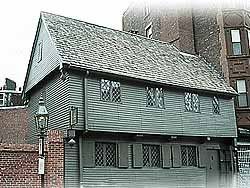
The place where the ride started, the Paul Revere House in North Square, Boston
Revere's place in the history of the American republic is a solid one. His contributions, especially on the night of April 18/19, 1775 were signal ones. Deconstructionists can try to pick holes in his cloak all they want. But solid fact backs up his solid and valuable role.
Paul Revere has left three accounts, some more circumstantial than others, of his midnight ride on the night of April 18/19, 1775. The first is a deposition taken in a few days after the events, for the purpose of "proving" that the British fired first on Lexington Green.
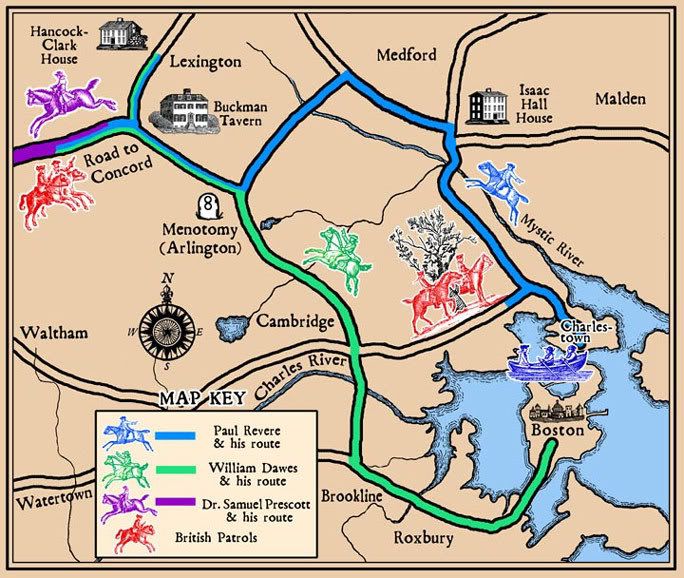
Map of the Rides of Revere, Dawes, and Prescott, courtesy of the Paul Revere House
I, PAUL REVERE, of Boston, in the colony of the Massachusetts Bay in New England; of lawful age, do testify and say; that I was sent for by Dr. Joseph Warren, of said Boston, on the evening of the 18th of April, about 10 o'clock; when he desired me, "to go to Lexington, and inform Mr. Samuel Adams, and the Hon. John Hancock Esq. that there was a number of soldiers, composed of light troops, and grenadiers, marching to the bottom of the common, where there was a number of boats to receive them; it was supposed that they were going to Lexington, by the way of Cambridge River, to take them, or go to Concord, to destroy the colony stores."
I proceeded immediately, and was put across Charles River and landed near Charlestown Battery; went in town, and there got a horse. While in Charlestown, I was informed by Richard Devens Esq. that he met that evening, after sunset, nine officers of the ministerial army, mounted on good horses, and armed, going towards Concord.
I set off, it was then about 11 o'clock, the moon shone bright. I had got almost over Charlestown Common, towards Cambridge, when I saw two officers on horse-back, standing under the shade of a tree, in a narrow part of the road. I was near enough to see their holsters and cockades. One of them started his horse towards me, the other up the road, as I supposed, to head me, should I escape the first. I turned my horse short about, and rode upon a full gallop for Mistick Road. He followed me about 300 yards, and finding he could not catch me, returned. I proceeded to Lexington, through Mistick, and alarmed Mr. Adams and Col. Hancock.
After I had been there about half an hour Mr. Daws arrived, who came from Boston, over the Neck.
We set off for Concord, and were overtaken by a young gentleman named Prescot, who belonged to Concord, and was going home. When we had got about half way from Lexington to Concord, the other two stopped at a house to awake the men, I kept along. When I had got about 200 yards ahead of them, I saw two officers as before. I called to my company to come up, saying here was two of them, (for I had told them what Mr. Devens told me, and of my being stopped). In an instant I saw four of them, who rode up to me with their pistols in their hands, said "G---d d---n you, stop. If you go an inch further, you are a dead man." Immediately Mr. Prescot came up. We attempted to get through them, but they kept before us, and swore if we did not turn in to that pasture, they would blow our brains out, (they had placed themselves opposite to a pair of bars, and had taken the bars down). They forced us in. When we had got in, Mr. Prescot said "Put on!" He took to the left, I to the right towards a wood at the bottom of the pasture, intending, when I gained that, to jump my horse and run afoot. Just as I reached it, out started six officers, seized my bridle, put their pistols to my breast, ordered me to dismount, which I did. One of them, who appeared to have the command there, and much of a gentleman, asked me where I came from; I told him. He asked what time I left. I told him, he seemed surprised, said "Sir, may I crave your name?" I answered "My name is Revere." "What" said he, "Paul Revere?" I answered "Yes." The others abused much; but he told me not to be afraid, no one should hurt me. I told him they would miss their aim. He said they should not, they were only waiting for some deserters they expected down the road. I told him I knew better, I knew what they were after; that I had alarmed the country all the way up, that their boats were caught aground, and I should have 500 men there soon. One of them said they had 1500 coming; he seemed surprised and rode off into the road, and informed them who took me, they came down immediately on a full gallop. One of them (whom I since learned was Major Mitchel of the 5th Reg.) clapped his pistol to my head, and said he was going to ask me some questions, and if I did not tell the truth, he would blow my brains out. I told him I esteemed myself a man of truth, that he had stopped me on the highway, and made me a prisoner, I knew not by what right; I would tell him the truth; I was not afraid. He then asked me the same questions that the other did, and many more, but was more particular; I gave him much the same answers. He then ordered me to mount my horse, they first searched me for pistols. When I was mounted, the Major took the reins out of my hand, and said "By G---d Sir, you are not to ride with reins I assure you;" and gave them to an officer on my right, to lead me. He then ordered 4 men out of the bushes, and to mount their horses; they were country men which they had stopped who were going home; then ordered us to march. He said to me, "We are now going towards your friends, and if you attempt to run, or we are insulted, we will blow your brains out." When we had got into the road they formed a circle, and ordered the prisoners in the center, and to lead me in the front. We rode towards Lexington at a quick pace; they very often insulted me calling me rebel, etc., etc. After we had got about a mile, I was given to the sergeant to lead, he was ordered to take out his pistol, (he rode with a hanger,) and if I ran, to execute the major's sentence.
When we got within about half a mile of the Meeting House we heard a gun fired. The Major asked me what it was for, I told him to alarm the country; he ordered the four prisoners to dismount, they did, then one of the officers dismounted and cut the bridles and saddles off the horses, and drove them away, and told the men they might go about their business. I asked the Major to dismiss me, he said he would carry me, let the consequence be what it will. He then ordered us to march.
When we got within sight of the Meeting House, we heard a volley of guns fired, as I supposed at the tavern, as an alarm; the Major ordered us to halt, he asked me how far it was to Cambridge, and many more questions, which I answered. He then asked the sergeant, if his horse was tired, he said yes; he ordered him to take my horse. I dismounted, and the sergeant mounted my horse; they cut the bridle and saddle of the sergeant's horse, and rode off down the road. I then went to the house were I left Messrs. Adams and Hancock, and told them what had happened; their friends advised them to go out of the way; I went with them, about two miles across road.
After resting myself, I set off with another man to go back to the tavern, to inquire the news; when we got there, we were told the troops were within two miles. We went into the tavern to get a trunk of papers belonging to Col. Hancock. Before we left the house, I saw the ministerial troops from the chamber window. We made haste, and had to pass through our militia, who were on a green behind the Meeting House, to the number as I supposed, about 50 or 60, I went through them; as I passed I heard the commanding officer speak to his men to this purpose; "Let the troops pass by, and don't molest them, without they begin first." I had to go across road; but had not got half gunshot off, when the ministerial troops appeared in sight, behind the Meeting House. They made a short halt, when one gun was fired. I heard the report, turned my head, and saw the smoke in front of the troops. They immediately gave a great shout, ran a few paces, and then the whole fired. I could first distinguish irregular firing, which I supposed was the advance guard, and then platoons; at this time I could not see our militia, for they were covered from me by a house at the bottom of the street.
s/PAUL REVERE.
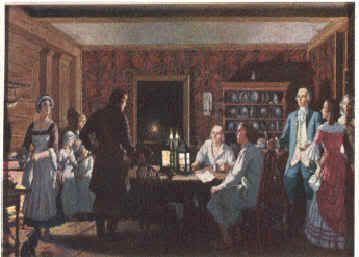
Revere informing Hancock and Adams of the approach of Lt. Col. Smith's troops in the Lexington parsonage, painted by A. Lassell Ripley
The second account he wrote in a letter to Jeremy Belknap, the Secretary of the Massachusetts Historical society in 1798, 23 years after the fact.
A LETTER FROM COL. PAUL REVERE TO THE CORRESPONDING SECRETARY
[Jeremy Belknap].
Dear Sir,
Having a little leisure, I wish to fullfill my promise, of giving you some facts, and Anecdotes, prior to the Battle of Lexington, which I do not remember to have seen in any history of the American Revolution.
In the year 1773 I was imployed by the Select men of the Town of Boston to carry the Account of the Destruction of the Tea to New-York; and afterwards, 1774, to Carry their dispatches to New-York and Philadelphia for Calling a Congress; and afterwards to Congress, several times. In the Fall of 1774 and Winter of 1775 I was one of upwards of thirty, cheifly mechanics, who formed our selves in to a Committee for the purpose of watching the Movements of the British Soldiers, and gaining every intelegence of the movements of the Tories. We held our meetings at the Green-Dragon Tavern. We were so carefull that our meetings should be kept Secret; that every time we met, every person swore upon the Bible, that they would not discover any of our transactions, But to Messrs. HANCOCK, ADAMS, Doctors WARREN, CHURCH, and one or two more.
About November, when things began to grow Serious, a Gentleman who had Conections with the Tory party, but was a Whig at heart, acquainted me, that our meetings were discovered, and mentioned the identical words that were spoken among us the Night before. We did not then distrust Dr. Church, but supposed it must be some one among us. We removed to another place, which we thought was more secure: but here we found that all our transactions were communicated to Governor Gage. (This came to me through the then Secretary Flucker; He told it to the Gentleman mentioned above). It was then a common opinion, that there was a Traytor in the provincial Congress, and that Gage was posessed of all their Secrets. (Church was a member of that Congress for Boston.) In the Winter, towards the Spring, we frequently took Turns, two and two, to Watch the Soldiers, By patroling the Streets all night. The Saturday Night preceding the 19th of April, about 12 oClock at Night, the Boats belonging to the Transports were all launched, and carried under the Sterns of the Men of War. (They had been previously hauld up and repaired). We likewise found that the Grenadiers and light Infantry were all taken off duty.
From these movements, we expected something serious was [to] be transacted. On Tuesday evening, the 18th, it was observed, that a number of Soldiers were marching towards the bottom of the Common. About 10 o'Clock, Dr. Warren Sent in great haste for me, and beged that I would imediately Set off for Lexington, where Messrs. Hancock and Adams were, and acquaint them of the Movement, and that it was thought they were the objets. When I got to Dr. Warren's house, I found he had sent an express by land to Lexington—a Mr. Wm. Daws. The Sunday before, by desire of Dr. Warren, I had been to Lexington, to Mess. Hancock and Adams, who were at the Rev. Mr. Clark's. I returned at Night thro Charlestown; there I agreed with a Col. Conant, and some other Gentlemen, that if the British went out by Water, we would shew two Lanthorns in the North Church Steeple; and if by Land, one, as a Signal; for we were aprehensive it would be dificult to Cross the Charles River, or git over Boston neck. I left Dr. Warrens, called upon a friend, and desired him to make the Signals. I then went Home, took my Boots and Surtout, and went to the North part of the Town, Where I had kept a Boat; two friends rowed me across Charles River, a little to the eastward where the Somerset Man of War lay. It was then young flood, the Ship was winding, and the moon was Rising. They landed me on Charlestown side. When I got into Town, I met Col. Conant, and several others; they said they had seen our signals. I told them what was Acting, and went to git me a Horse; I got a Horse of Deacon Larkin. While the Horse was preparing, Richard Devens, Esq. who was one of the Committee of Safty, came to me, and told me, that he came down the Road from Lexington, after Sundown, that evening; that He met ten British Officers, all well mounted, and armed, going up the Road.
I set off upon a very good Horse; it was then about 11 o'Clock, and very pleasant. After I had passed Charlestown Neck, and got nearly opposite where Mark was hung in chains, I saw two men on Horse back, under a Tree. When I got near them, I discovered they were British officer. One tryed to git a head of Me, and the other to take me. I turned my Horse very quick, and Galloped towards Charlestown neck, and then pushed for the Medford Road. The one who chased me, endeavoring to Cut me off, got into a Clay pond, near where the new Tavern is now built. I got clear of him, and went thro Medford, over the Bridge, and up to Menotomy. In Medford, I awaked the Captain of the Minute men; and after that, I alarmed almost every House, till I got to Lexington. I found Messrs. Hancock and Adams at the Rev. Mr. Clark's; I told them my errand, and inquired for Mr. Daws; they said he had not been there; I related the story of the two officers, and supposed that He must have been stopped, as he ought to have been there before me. After I had been there about half an Hour, Mr. Daws came; we refreshid our selves, and set off for Concord, to secure the Stores, &c. there. We were overtaken by a young Docter Prescot, whom we found to be a high Son of Liberty. I told them of the ten officers that Mr. Devens mett, and that it was probable we might be stoped before we got to Concord; for I supposed that after Night, they divided them selves, and that two of them had fixed themselves in such passages as were most likely to stop any intelegence going to Concord. I likewise mentioned, that we had better allarm all the Inhabitents till we got to Concord; the young Doctor much approved of it, and said, he would stop with either of us, for the people between that and Concord knew him, and would give the more credit to what we said. We had got nearly half way. Mr Daws and the Doctor stoped to allarm the people of a House: I was about one hundred Rod a head, when I saw two men, in nearly the same situation as those officer were, near Charlestown. I called for the Doctor and Daws to come up;—in an Instant I was surrounded by four;—they had placed themselves in a Straight Road, that inclined each way; they had taken down a pair of Barrs on the North side of the Road, and two of them were under a tree in the pasture. The Docter being foremost, he came up; and we tryed to git past them; but they being armed with pistols and swords, they forced us in to the pasture;—the Docter jumped his Horse over a low Stone wall, and got to Concord. I observed a Wood at a Small distance, and made for that. When I got there, out Started Six officers, on Horse back, and orderd me to dismount;—one of them, who appeared to have the command, examined me, where I came from, and what my Name Was? I told him. He asked me if I was an express? I answered in the afirmative. He demanded what time I left Boston? I told him; and aded, that their troops had catched aground in passing the River, and that There would be five hundred Americans there in a short time, for I had alarmed the Country all the way up. He imediately rode towards those who stoppd us, when all five of them came down upon a full gallop; one of them, whom I afterwards found to be Major Mitchel, of the 5th Regiment, Clapped his pistol to my head, called me by name, and told me he was going to ask me some questions, and if I did not give him true answers, he would blow my brains out. He then asked me similar questions to those above. He then orderd me to mount my Horse, after searching me for arms. He then orderd them to advance, and to lead me in front. When we got to the Road, they turned down towards Lexington. When we had got about one Mile, the Major Rode up to the officer that was leading me, and told him to give me to the Sergeant. As soon as he took me, the Major orderd him, if I attempted to run, or any body insulted them, to blow my brains out. We rode till we got near Lexington Meeting-house, when the Militia fired a Voley of Guns, which appeared to alarm them very much. The Major inquired of me how far it was to Cambridge, and if there were any other Road? After some consultation, the Major Rode up to the Sargent, and asked if his Horse was tired? He answered him, he was--(He was a Sargent of Grenadiers, and had a small Horse)—then, said He, take that man's Horse. I dismounted, and the Sargent mounted my Horse, when they all rode towards Lexington Meeting-House. I went across the Burying-ground, and some pastures, and came to the Revd. Mr. Clark's House, where I found Messrs. Hancok and Adams. I told them of my treatment, and they concluded to go from that House to wards Woburn. I went with them, and a Mr. Lowell, who was a Clerk to Mr. Hancock. When we got to the House where they intended to stop, Mr. Lowell and my self returned to Mr. Clark's, to find what was going on. When we got there, an elderly man came in; he said he had just come from the Tavern, that a Man had come from Boston, who said there were no British troops coming. Mr. Lowell and my self went towards the Tavern, when we met a Man on a full gallop, who told us the Troops were coming up the Rocks. We afterwards met another, who said they were close by. Mr. Lowell asked me to go to the Tavern with him, to git a Trunk of papers belonging to Mr. Hancock. We went up Chamber; and while we were giting the Trunk, we saw the British very near, upon a full March. We hurried to wards Mr. Clark's House. In our way, we passed through the Militia. There were about 50. When we had got about 100 Yards from the meeting-House the British Troops appeard on both Sides of the Meeting-House. In their Front was an Officer on Horse back. They made a Short Halt; when I saw, and heard, a Gun fired, which appeared to be a Pistol. Then I could distinguish two Guns, and then a Continual roar of Musquetry; When we made off with the Trunk.
As I have mentioned Dr. Church, perhaps it might not be disagreeable to mention some Matters of my own knowledge, respecting Him. He appeared to be a high son of Liberty. He frequented all the places where they met, Was incouraged by all the leaders of the Sons of Liberty, and it appeared he was respected by them, though I knew that Dr. Warren had not the greatest affection for him. He was esteemed a very capable writer, especially in verese; and as the Whig party needed every Strenght, they feared, as well as courted Him. Though it was known, that some of the Liberty Songs, which We composed, were parodized by him, in favor of the British, yet none dare charge him with it. I was a constant and critical observer of him, and I must say, that I never thought Him a man of Principle; and I doubted much in my own mind, wether He was a real Whig. I knew that He kept company with a Capt. Price, a half-pay British officer, and that He frequently dined with him, and Robinson, one of the Commissioners. I know that one of his intimate aquaintances asked him why he was so often with Robinson and Price? His answer was, that He kept Company with them on purpose to find out their plans. The day after the Battle of Lexington, I met him in Cambridge, when He shew me some blood on his stocking, which he said spirted on him from a Man who was killed near him, as he was urging the Militia on. I well remember, that I argued with my self, if a Man will risque his life in a Cause, he must be a Friend to that cause; and I never suspected him after, till He was charged with being a Traytor.
The same day I met Dr. Warren. He was President of the Committee of Safety. He engaged me as a Messinger, to do the out of doors business for that committee; which gave me an opportunity of being frequently with them. The Friday evening after, about sun set, I was sitting with some, or near all that Committee, in their room, which was at Mr. Hastings's House at Cambridge. Dr. Church, all at once, started up—Dr. Warren, said He, I am determined to go into Boston tomorrow—(it set them all a stairing)—Dr. Warren replyed, Are you serious, Dr. Church? they will Hang you if they catch you in Boston. He replyed, I am serious, and am determined to go at all adventures. After a considerable conversation, Dr. Warren said, If you are determined, let us make some business for you. They agreed that he should go to git medicine for their and our Wounded officers. He went the next morning; and I think he came back on Sunday evening. After He had told the Committee how things were, I took him a side, and inquired particularly how they treated him? he said, that as soon as he got to their lines on Boston Neck, they made him a prisoner, and carried him to General Gage, where He was examined, and then He was sent to Gould's Barracks, and was not suffered to go home but once. After He was taken up, for holding a Correspondence with the Brittish, I came a Cross Deacon Caleb Davis;—we entred into Conversation about Him;—He told me, that the morning Church went into Boston, He (Davis) received a Bilet for General Gage—(he then did not know that Church was in Town)—When he got to the General's House, he was told, the General could not be spoke with, that He was in private with a Gentleman; that He waited near half an Hour,—When General Gage and Dr. Church came out of a Room, discoursing together, like persons who had been long aquainted. He appeared to be quite surprized at seeing Deacon Davis there; that he (Church) went where he pleased, while in Boston, only a Major Caine, one of Gage's Aids, went with him. I was told by another person whom I could depend upon, that he saw Church go in to General Gage's House, at the above time; that He got out of the Chaise and went up the steps more like a Man that was aquainted, than a prisoner.
Sometime after, perhaps a Year or two, I fell in company with a Gentleman who studied with Church—in discoursing about him, I related what I have mentioned above; He said, He did not doubt that He was in the Interest of the Brittish; and that it was He who informed Gen. Gage That he knew for Certain, that a Short time before the Battle of Lexington, (for He then lived with Him, and took Care of his Business and Books) He had no money by him, and was much drove for money; that all at once, He had several Hundred New Brittish Guineas; and that He thought at the time, where they came from.
Thus, Sir, I have endeavoured to give you a Short detail of some matters, of which perhaps no person but my self have documents, or knowledge. I have mentioned some names which you are aquainted with: I wish you would Ask them, if they can remember the Circumstances I alude to.
I am, Sir, with every Sentment of esteem,
Your Humble Servant,
Paul Revere
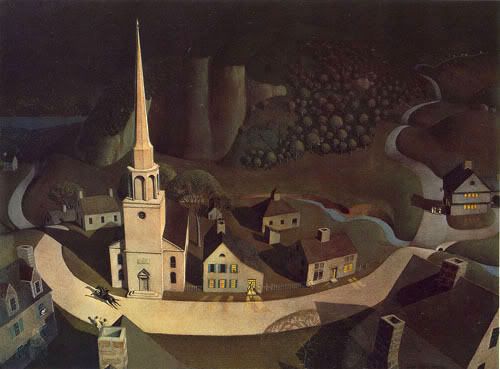
Artist Grant Wood's rather sterile and lifeless interpretation of Paul Revere's Ride
Historian David Hackett Fischer in Paul Revere's Ride describes the importance of Revere's effort that night. Revere was a man of many talents and many connections. He was known as a leader in the Sons of Liberty and many other organizations. Everywhere he went on his journey, he awakened and met people he knew, and informed them of what Dr. Warren had charged him with. He got results, In Charlestown, in Medford, in Menotomy, and in Lexington, all he had to do was make a stop at a single house, and alert the minister, the principal officer of the militia, the head of the town meeting. That single stop would be sufficient to alarm the town. And his message was instantly relayed in other directions by many other couriers setting off in his wake. He was a civic organizer of the sort we would all recognize from the Knights of Columbus or Elks. He was the sort of fellow who got the task done, where others did less.
Much has been said to the effect that Dr. Samuel Prescott and especially William Dawes did not get their share of the credit for the alarm of the British march. Well, Longfellow did not write about them, that is true.
But there was a difference in what Dawes did, and what Revere did. Like Revere, Dawes was charged with alerting Hancock and Admas, staying in Lexington at Hancock's cousin's parsonage, the Reverend Clarke's, about the approach of the redcoats. His route was overland, past the sentry on Boston Neck, then looping through Roxbury, and Cambridge, until he ended up on the same road as Revere. Dawes conned his way past the British sentry (who wasn't supposed to be letting anyone out of Boston) and did just what he was asked. He rode to Lexington to alert Hancock and Adams. There is no evidence that he alerted anyone else before he got there. He made no stops. No other couriers set off in different directions in his wake. He did what he was asked, but lacked the connections outside of Boston that Revere had that enabled him to use an economy of effort in alerting the countryside.
So Paul Revere did not undertake his mission as some solitary icon. He did not ride alone, as the Grant Wood illustration implies, through a barren and sterile New England countryside. He did what he did as part of a team. But what made his work different was that, as a civic booster of the sort we are all familiar with, he was able to set in motion the institutions of Middlesex County in a way no one else similarly situated in life could.
Do yourself a favor this year. Put aside Longfellow's poem. Read Fischer's book, instead. Get to know Paul Revere much better, and I think you will be enriched by the experience.
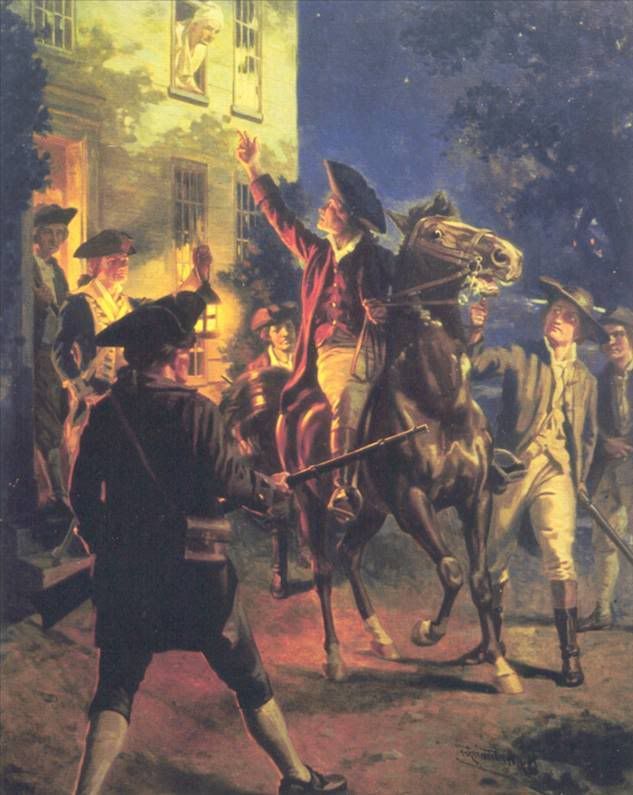
I like this image of Revere alerting sergeant Monroe's guard in front of the Lexington parsonage, except, what is Monroe doing in a Continental Army uniform long before the creation of the Continental Army?

The white picket fence in 18th Century Massachusetts is a touching, but anachronistic touch

He didn't need to ride this fast. he and Deacon Larkin's horse would have been severely injured, if he did.
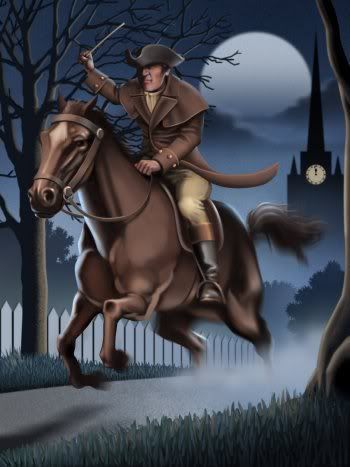
Again with the white picket fence!
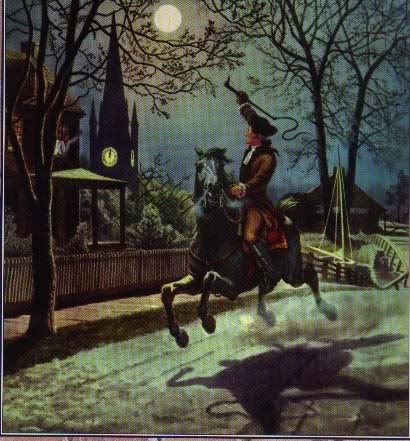
Wow, a gothic parish church, and Revere brandishing a swagger stick!
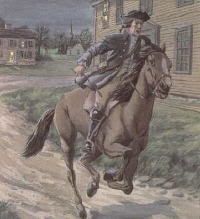
Some thought and research went into this one.
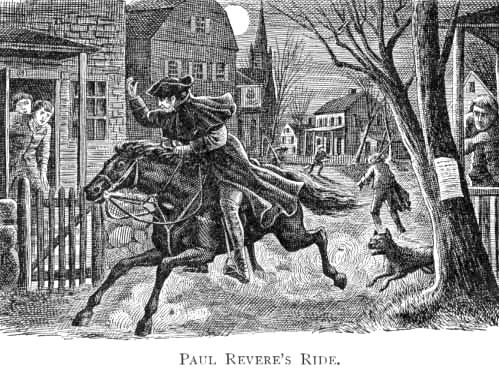
Too many people instantly stirring, and another gothic steeple in the background

The problem with this one (and it is echoed in Longfellow) is that Revere did not need to wait for the lanterns in the steeple of Old North. He knew perfectly well that the redcoats were being rowed across the Charles to Lechmere Point in Cambridge. The lanterns were a pre-arranged signal to alert others in case Revere did not make it over.
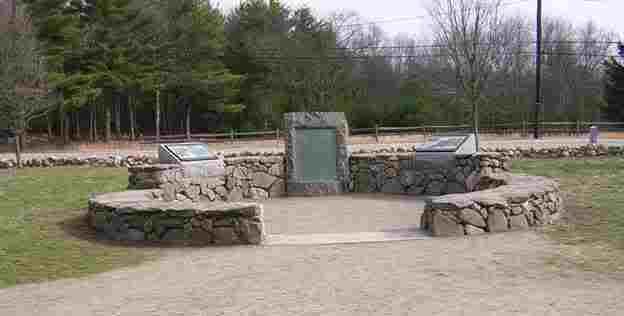
The approximate location where Revere was captured, and the midnight ride ended. It is along Route 2A on the Battle Road between Lincoln and Concord, within Minuteman National Historical Park

Portrait by John Singleton Copley, c. 1772
Unfortunately, the details of what he did and why it was important are lost on a generation with ancestoral roots substantially substantially removed from the millieau of colonial New England, the British Isles, or even Western Civilization as we have known it.
The image of the solitary Midnight Ride at least used to be engraved on the American psyche, along with all the historical errors of Longfellow's poem. Revere became an icon of American history.
But Revere has been subjected to quite a bit of pointless "historical" and critical deconstruction. One very odd effort in that way implies that Revere sang like a canary to his captors out of fear. It was even illustrated with a likeness based on the Copley portrait, but winged like a whistling canary and sweating bullets as he spilled his guts.
Another effort of deconstruction implied that Paul Revere never rode that night at all. That led President Warren Harding, not the sharpest knife in the drawer, to blurt out, "I love Paul Revere, whether he rode or not!"
And there is the Texas joke that many are familiar with. A Texan was regaling an audience about the bravery of Texans past. He talked of the defenders of the Alamo, when less than 150 men held off 5,000 fully-armed Mexican soldiers for days on end, killing vast numbers of them before being overwhelmed by sheer numbers. He described the Texas Ranger who went out alone after a gang, killed some of them, and came back leading more than a dozen prisoner.
A New Englander couldn't stand it any longer, and said, "Well, we in New England have our heroes, too. Like Paul Revere."
"You mean the Yankee who ran to get help?"

The place where the ride started, the Paul Revere House in North Square, Boston
Revere's place in the history of the American republic is a solid one. His contributions, especially on the night of April 18/19, 1775 were signal ones. Deconstructionists can try to pick holes in his cloak all they want. But solid fact backs up his solid and valuable role.
Paul Revere has left three accounts, some more circumstantial than others, of his midnight ride on the night of April 18/19, 1775. The first is a deposition taken in a few days after the events, for the purpose of "proving" that the British fired first on Lexington Green.

Map of the Rides of Revere, Dawes, and Prescott, courtesy of the Paul Revere House
I, PAUL REVERE, of Boston, in the colony of the Massachusetts Bay in New England; of lawful age, do testify and say; that I was sent for by Dr. Joseph Warren, of said Boston, on the evening of the 18th of April, about 10 o'clock; when he desired me, "to go to Lexington, and inform Mr. Samuel Adams, and the Hon. John Hancock Esq. that there was a number of soldiers, composed of light troops, and grenadiers, marching to the bottom of the common, where there was a number of boats to receive them; it was supposed that they were going to Lexington, by the way of Cambridge River, to take them, or go to Concord, to destroy the colony stores."
I proceeded immediately, and was put across Charles River and landed near Charlestown Battery; went in town, and there got a horse. While in Charlestown, I was informed by Richard Devens Esq. that he met that evening, after sunset, nine officers of the ministerial army, mounted on good horses, and armed, going towards Concord.
I set off, it was then about 11 o'clock, the moon shone bright. I had got almost over Charlestown Common, towards Cambridge, when I saw two officers on horse-back, standing under the shade of a tree, in a narrow part of the road. I was near enough to see their holsters and cockades. One of them started his horse towards me, the other up the road, as I supposed, to head me, should I escape the first. I turned my horse short about, and rode upon a full gallop for Mistick Road. He followed me about 300 yards, and finding he could not catch me, returned. I proceeded to Lexington, through Mistick, and alarmed Mr. Adams and Col. Hancock.
After I had been there about half an hour Mr. Daws arrived, who came from Boston, over the Neck.
We set off for Concord, and were overtaken by a young gentleman named Prescot, who belonged to Concord, and was going home. When we had got about half way from Lexington to Concord, the other two stopped at a house to awake the men, I kept along. When I had got about 200 yards ahead of them, I saw two officers as before. I called to my company to come up, saying here was two of them, (for I had told them what Mr. Devens told me, and of my being stopped). In an instant I saw four of them, who rode up to me with their pistols in their hands, said "G---d d---n you, stop. If you go an inch further, you are a dead man." Immediately Mr. Prescot came up. We attempted to get through them, but they kept before us, and swore if we did not turn in to that pasture, they would blow our brains out, (they had placed themselves opposite to a pair of bars, and had taken the bars down). They forced us in. When we had got in, Mr. Prescot said "Put on!" He took to the left, I to the right towards a wood at the bottom of the pasture, intending, when I gained that, to jump my horse and run afoot. Just as I reached it, out started six officers, seized my bridle, put their pistols to my breast, ordered me to dismount, which I did. One of them, who appeared to have the command there, and much of a gentleman, asked me where I came from; I told him. He asked what time I left. I told him, he seemed surprised, said "Sir, may I crave your name?" I answered "My name is Revere." "What" said he, "Paul Revere?" I answered "Yes." The others abused much; but he told me not to be afraid, no one should hurt me. I told him they would miss their aim. He said they should not, they were only waiting for some deserters they expected down the road. I told him I knew better, I knew what they were after; that I had alarmed the country all the way up, that their boats were caught aground, and I should have 500 men there soon. One of them said they had 1500 coming; he seemed surprised and rode off into the road, and informed them who took me, they came down immediately on a full gallop. One of them (whom I since learned was Major Mitchel of the 5th Reg.) clapped his pistol to my head, and said he was going to ask me some questions, and if I did not tell the truth, he would blow my brains out. I told him I esteemed myself a man of truth, that he had stopped me on the highway, and made me a prisoner, I knew not by what right; I would tell him the truth; I was not afraid. He then asked me the same questions that the other did, and many more, but was more particular; I gave him much the same answers. He then ordered me to mount my horse, they first searched me for pistols. When I was mounted, the Major took the reins out of my hand, and said "By G---d Sir, you are not to ride with reins I assure you;" and gave them to an officer on my right, to lead me. He then ordered 4 men out of the bushes, and to mount their horses; they were country men which they had stopped who were going home; then ordered us to march. He said to me, "We are now going towards your friends, and if you attempt to run, or we are insulted, we will blow your brains out." When we had got into the road they formed a circle, and ordered the prisoners in the center, and to lead me in the front. We rode towards Lexington at a quick pace; they very often insulted me calling me rebel, etc., etc. After we had got about a mile, I was given to the sergeant to lead, he was ordered to take out his pistol, (he rode with a hanger,) and if I ran, to execute the major's sentence.
When we got within about half a mile of the Meeting House we heard a gun fired. The Major asked me what it was for, I told him to alarm the country; he ordered the four prisoners to dismount, they did, then one of the officers dismounted and cut the bridles and saddles off the horses, and drove them away, and told the men they might go about their business. I asked the Major to dismiss me, he said he would carry me, let the consequence be what it will. He then ordered us to march.
When we got within sight of the Meeting House, we heard a volley of guns fired, as I supposed at the tavern, as an alarm; the Major ordered us to halt, he asked me how far it was to Cambridge, and many more questions, which I answered. He then asked the sergeant, if his horse was tired, he said yes; he ordered him to take my horse. I dismounted, and the sergeant mounted my horse; they cut the bridle and saddle of the sergeant's horse, and rode off down the road. I then went to the house were I left Messrs. Adams and Hancock, and told them what had happened; their friends advised them to go out of the way; I went with them, about two miles across road.
After resting myself, I set off with another man to go back to the tavern, to inquire the news; when we got there, we were told the troops were within two miles. We went into the tavern to get a trunk of papers belonging to Col. Hancock. Before we left the house, I saw the ministerial troops from the chamber window. We made haste, and had to pass through our militia, who were on a green behind the Meeting House, to the number as I supposed, about 50 or 60, I went through them; as I passed I heard the commanding officer speak to his men to this purpose; "Let the troops pass by, and don't molest them, without they begin first." I had to go across road; but had not got half gunshot off, when the ministerial troops appeared in sight, behind the Meeting House. They made a short halt, when one gun was fired. I heard the report, turned my head, and saw the smoke in front of the troops. They immediately gave a great shout, ran a few paces, and then the whole fired. I could first distinguish irregular firing, which I supposed was the advance guard, and then platoons; at this time I could not see our militia, for they were covered from me by a house at the bottom of the street.
s/PAUL REVERE.

Revere informing Hancock and Adams of the approach of Lt. Col. Smith's troops in the Lexington parsonage, painted by A. Lassell Ripley
The second account he wrote in a letter to Jeremy Belknap, the Secretary of the Massachusetts Historical society in 1798, 23 years after the fact.
A LETTER FROM COL. PAUL REVERE TO THE CORRESPONDING SECRETARY
[Jeremy Belknap].
Dear Sir,
Having a little leisure, I wish to fullfill my promise, of giving you some facts, and Anecdotes, prior to the Battle of Lexington, which I do not remember to have seen in any history of the American Revolution.
In the year 1773 I was imployed by the Select men of the Town of Boston to carry the Account of the Destruction of the Tea to New-York; and afterwards, 1774, to Carry their dispatches to New-York and Philadelphia for Calling a Congress; and afterwards to Congress, several times. In the Fall of 1774 and Winter of 1775 I was one of upwards of thirty, cheifly mechanics, who formed our selves in to a Committee for the purpose of watching the Movements of the British Soldiers, and gaining every intelegence of the movements of the Tories. We held our meetings at the Green-Dragon Tavern. We were so carefull that our meetings should be kept Secret; that every time we met, every person swore upon the Bible, that they would not discover any of our transactions, But to Messrs. HANCOCK, ADAMS, Doctors WARREN, CHURCH, and one or two more.
About November, when things began to grow Serious, a Gentleman who had Conections with the Tory party, but was a Whig at heart, acquainted me, that our meetings were discovered, and mentioned the identical words that were spoken among us the Night before. We did not then distrust Dr. Church, but supposed it must be some one among us. We removed to another place, which we thought was more secure: but here we found that all our transactions were communicated to Governor Gage. (This came to me through the then Secretary Flucker; He told it to the Gentleman mentioned above). It was then a common opinion, that there was a Traytor in the provincial Congress, and that Gage was posessed of all their Secrets. (Church was a member of that Congress for Boston.) In the Winter, towards the Spring, we frequently took Turns, two and two, to Watch the Soldiers, By patroling the Streets all night. The Saturday Night preceding the 19th of April, about 12 oClock at Night, the Boats belonging to the Transports were all launched, and carried under the Sterns of the Men of War. (They had been previously hauld up and repaired). We likewise found that the Grenadiers and light Infantry were all taken off duty.
From these movements, we expected something serious was [to] be transacted. On Tuesday evening, the 18th, it was observed, that a number of Soldiers were marching towards the bottom of the Common. About 10 o'Clock, Dr. Warren Sent in great haste for me, and beged that I would imediately Set off for Lexington, where Messrs. Hancock and Adams were, and acquaint them of the Movement, and that it was thought they were the objets. When I got to Dr. Warren's house, I found he had sent an express by land to Lexington—a Mr. Wm. Daws. The Sunday before, by desire of Dr. Warren, I had been to Lexington, to Mess. Hancock and Adams, who were at the Rev. Mr. Clark's. I returned at Night thro Charlestown; there I agreed with a Col. Conant, and some other Gentlemen, that if the British went out by Water, we would shew two Lanthorns in the North Church Steeple; and if by Land, one, as a Signal; for we were aprehensive it would be dificult to Cross the Charles River, or git over Boston neck. I left Dr. Warrens, called upon a friend, and desired him to make the Signals. I then went Home, took my Boots and Surtout, and went to the North part of the Town, Where I had kept a Boat; two friends rowed me across Charles River, a little to the eastward where the Somerset Man of War lay. It was then young flood, the Ship was winding, and the moon was Rising. They landed me on Charlestown side. When I got into Town, I met Col. Conant, and several others; they said they had seen our signals. I told them what was Acting, and went to git me a Horse; I got a Horse of Deacon Larkin. While the Horse was preparing, Richard Devens, Esq. who was one of the Committee of Safty, came to me, and told me, that he came down the Road from Lexington, after Sundown, that evening; that He met ten British Officers, all well mounted, and armed, going up the Road.
I set off upon a very good Horse; it was then about 11 o'Clock, and very pleasant. After I had passed Charlestown Neck, and got nearly opposite where Mark was hung in chains, I saw two men on Horse back, under a Tree. When I got near them, I discovered they were British officer. One tryed to git a head of Me, and the other to take me. I turned my Horse very quick, and Galloped towards Charlestown neck, and then pushed for the Medford Road. The one who chased me, endeavoring to Cut me off, got into a Clay pond, near where the new Tavern is now built. I got clear of him, and went thro Medford, over the Bridge, and up to Menotomy. In Medford, I awaked the Captain of the Minute men; and after that, I alarmed almost every House, till I got to Lexington. I found Messrs. Hancock and Adams at the Rev. Mr. Clark's; I told them my errand, and inquired for Mr. Daws; they said he had not been there; I related the story of the two officers, and supposed that He must have been stopped, as he ought to have been there before me. After I had been there about half an Hour, Mr. Daws came; we refreshid our selves, and set off for Concord, to secure the Stores, &c. there. We were overtaken by a young Docter Prescot, whom we found to be a high Son of Liberty. I told them of the ten officers that Mr. Devens mett, and that it was probable we might be stoped before we got to Concord; for I supposed that after Night, they divided them selves, and that two of them had fixed themselves in such passages as were most likely to stop any intelegence going to Concord. I likewise mentioned, that we had better allarm all the Inhabitents till we got to Concord; the young Doctor much approved of it, and said, he would stop with either of us, for the people between that and Concord knew him, and would give the more credit to what we said. We had got nearly half way. Mr Daws and the Doctor stoped to allarm the people of a House: I was about one hundred Rod a head, when I saw two men, in nearly the same situation as those officer were, near Charlestown. I called for the Doctor and Daws to come up;—in an Instant I was surrounded by four;—they had placed themselves in a Straight Road, that inclined each way; they had taken down a pair of Barrs on the North side of the Road, and two of them were under a tree in the pasture. The Docter being foremost, he came up; and we tryed to git past them; but they being armed with pistols and swords, they forced us in to the pasture;—the Docter jumped his Horse over a low Stone wall, and got to Concord. I observed a Wood at a Small distance, and made for that. When I got there, out Started Six officers, on Horse back, and orderd me to dismount;—one of them, who appeared to have the command, examined me, where I came from, and what my Name Was? I told him. He asked me if I was an express? I answered in the afirmative. He demanded what time I left Boston? I told him; and aded, that their troops had catched aground in passing the River, and that There would be five hundred Americans there in a short time, for I had alarmed the Country all the way up. He imediately rode towards those who stoppd us, when all five of them came down upon a full gallop; one of them, whom I afterwards found to be Major Mitchel, of the 5th Regiment, Clapped his pistol to my head, called me by name, and told me he was going to ask me some questions, and if I did not give him true answers, he would blow my brains out. He then asked me similar questions to those above. He then orderd me to mount my Horse, after searching me for arms. He then orderd them to advance, and to lead me in front. When we got to the Road, they turned down towards Lexington. When we had got about one Mile, the Major Rode up to the officer that was leading me, and told him to give me to the Sergeant. As soon as he took me, the Major orderd him, if I attempted to run, or any body insulted them, to blow my brains out. We rode till we got near Lexington Meeting-house, when the Militia fired a Voley of Guns, which appeared to alarm them very much. The Major inquired of me how far it was to Cambridge, and if there were any other Road? After some consultation, the Major Rode up to the Sargent, and asked if his Horse was tired? He answered him, he was--(He was a Sargent of Grenadiers, and had a small Horse)—then, said He, take that man's Horse. I dismounted, and the Sargent mounted my Horse, when they all rode towards Lexington Meeting-House. I went across the Burying-ground, and some pastures, and came to the Revd. Mr. Clark's House, where I found Messrs. Hancok and Adams. I told them of my treatment, and they concluded to go from that House to wards Woburn. I went with them, and a Mr. Lowell, who was a Clerk to Mr. Hancock. When we got to the House where they intended to stop, Mr. Lowell and my self returned to Mr. Clark's, to find what was going on. When we got there, an elderly man came in; he said he had just come from the Tavern, that a Man had come from Boston, who said there were no British troops coming. Mr. Lowell and my self went towards the Tavern, when we met a Man on a full gallop, who told us the Troops were coming up the Rocks. We afterwards met another, who said they were close by. Mr. Lowell asked me to go to the Tavern with him, to git a Trunk of papers belonging to Mr. Hancock. We went up Chamber; and while we were giting the Trunk, we saw the British very near, upon a full March. We hurried to wards Mr. Clark's House. In our way, we passed through the Militia. There were about 50. When we had got about 100 Yards from the meeting-House the British Troops appeard on both Sides of the Meeting-House. In their Front was an Officer on Horse back. They made a Short Halt; when I saw, and heard, a Gun fired, which appeared to be a Pistol. Then I could distinguish two Guns, and then a Continual roar of Musquetry; When we made off with the Trunk.
As I have mentioned Dr. Church, perhaps it might not be disagreeable to mention some Matters of my own knowledge, respecting Him. He appeared to be a high son of Liberty. He frequented all the places where they met, Was incouraged by all the leaders of the Sons of Liberty, and it appeared he was respected by them, though I knew that Dr. Warren had not the greatest affection for him. He was esteemed a very capable writer, especially in verese; and as the Whig party needed every Strenght, they feared, as well as courted Him. Though it was known, that some of the Liberty Songs, which We composed, were parodized by him, in favor of the British, yet none dare charge him with it. I was a constant and critical observer of him, and I must say, that I never thought Him a man of Principle; and I doubted much in my own mind, wether He was a real Whig. I knew that He kept company with a Capt. Price, a half-pay British officer, and that He frequently dined with him, and Robinson, one of the Commissioners. I know that one of his intimate aquaintances asked him why he was so often with Robinson and Price? His answer was, that He kept Company with them on purpose to find out their plans. The day after the Battle of Lexington, I met him in Cambridge, when He shew me some blood on his stocking, which he said spirted on him from a Man who was killed near him, as he was urging the Militia on. I well remember, that I argued with my self, if a Man will risque his life in a Cause, he must be a Friend to that cause; and I never suspected him after, till He was charged with being a Traytor.
The same day I met Dr. Warren. He was President of the Committee of Safety. He engaged me as a Messinger, to do the out of doors business for that committee; which gave me an opportunity of being frequently with them. The Friday evening after, about sun set, I was sitting with some, or near all that Committee, in their room, which was at Mr. Hastings's House at Cambridge. Dr. Church, all at once, started up—Dr. Warren, said He, I am determined to go into Boston tomorrow—(it set them all a stairing)—Dr. Warren replyed, Are you serious, Dr. Church? they will Hang you if they catch you in Boston. He replyed, I am serious, and am determined to go at all adventures. After a considerable conversation, Dr. Warren said, If you are determined, let us make some business for you. They agreed that he should go to git medicine for their and our Wounded officers. He went the next morning; and I think he came back on Sunday evening. After He had told the Committee how things were, I took him a side, and inquired particularly how they treated him? he said, that as soon as he got to their lines on Boston Neck, they made him a prisoner, and carried him to General Gage, where He was examined, and then He was sent to Gould's Barracks, and was not suffered to go home but once. After He was taken up, for holding a Correspondence with the Brittish, I came a Cross Deacon Caleb Davis;—we entred into Conversation about Him;—He told me, that the morning Church went into Boston, He (Davis) received a Bilet for General Gage—(he then did not know that Church was in Town)—When he got to the General's House, he was told, the General could not be spoke with, that He was in private with a Gentleman; that He waited near half an Hour,—When General Gage and Dr. Church came out of a Room, discoursing together, like persons who had been long aquainted. He appeared to be quite surprized at seeing Deacon Davis there; that he (Church) went where he pleased, while in Boston, only a Major Caine, one of Gage's Aids, went with him. I was told by another person whom I could depend upon, that he saw Church go in to General Gage's House, at the above time; that He got out of the Chaise and went up the steps more like a Man that was aquainted, than a prisoner.
Sometime after, perhaps a Year or two, I fell in company with a Gentleman who studied with Church—in discoursing about him, I related what I have mentioned above; He said, He did not doubt that He was in the Interest of the Brittish; and that it was He who informed Gen. Gage That he knew for Certain, that a Short time before the Battle of Lexington, (for He then lived with Him, and took Care of his Business and Books) He had no money by him, and was much drove for money; that all at once, He had several Hundred New Brittish Guineas; and that He thought at the time, where they came from.
Thus, Sir, I have endeavoured to give you a Short detail of some matters, of which perhaps no person but my self have documents, or knowledge. I have mentioned some names which you are aquainted with: I wish you would Ask them, if they can remember the Circumstances I alude to.
I am, Sir, with every Sentment of esteem,
Your Humble Servant,
Paul Revere

Artist Grant Wood's rather sterile and lifeless interpretation of Paul Revere's Ride
Historian David Hackett Fischer in Paul Revere's Ride describes the importance of Revere's effort that night. Revere was a man of many talents and many connections. He was known as a leader in the Sons of Liberty and many other organizations. Everywhere he went on his journey, he awakened and met people he knew, and informed them of what Dr. Warren had charged him with. He got results, In Charlestown, in Medford, in Menotomy, and in Lexington, all he had to do was make a stop at a single house, and alert the minister, the principal officer of the militia, the head of the town meeting. That single stop would be sufficient to alarm the town. And his message was instantly relayed in other directions by many other couriers setting off in his wake. He was a civic organizer of the sort we would all recognize from the Knights of Columbus or Elks. He was the sort of fellow who got the task done, where others did less.
Much has been said to the effect that Dr. Samuel Prescott and especially William Dawes did not get their share of the credit for the alarm of the British march. Well, Longfellow did not write about them, that is true.
But there was a difference in what Dawes did, and what Revere did. Like Revere, Dawes was charged with alerting Hancock and Admas, staying in Lexington at Hancock's cousin's parsonage, the Reverend Clarke's, about the approach of the redcoats. His route was overland, past the sentry on Boston Neck, then looping through Roxbury, and Cambridge, until he ended up on the same road as Revere. Dawes conned his way past the British sentry (who wasn't supposed to be letting anyone out of Boston) and did just what he was asked. He rode to Lexington to alert Hancock and Adams. There is no evidence that he alerted anyone else before he got there. He made no stops. No other couriers set off in different directions in his wake. He did what he was asked, but lacked the connections outside of Boston that Revere had that enabled him to use an economy of effort in alerting the countryside.
So Paul Revere did not undertake his mission as some solitary icon. He did not ride alone, as the Grant Wood illustration implies, through a barren and sterile New England countryside. He did what he did as part of a team. But what made his work different was that, as a civic booster of the sort we are all familiar with, he was able to set in motion the institutions of Middlesex County in a way no one else similarly situated in life could.
Do yourself a favor this year. Put aside Longfellow's poem. Read Fischer's book, instead. Get to know Paul Revere much better, and I think you will be enriched by the experience.

I like this image of Revere alerting sergeant Monroe's guard in front of the Lexington parsonage, except, what is Monroe doing in a Continental Army uniform long before the creation of the Continental Army?

The white picket fence in 18th Century Massachusetts is a touching, but anachronistic touch

He didn't need to ride this fast. he and Deacon Larkin's horse would have been severely injured, if he did.

Again with the white picket fence!

Wow, a gothic parish church, and Revere brandishing a swagger stick!

Some thought and research went into this one.

Too many people instantly stirring, and another gothic steeple in the background

The problem with this one (and it is echoed in Longfellow) is that Revere did not need to wait for the lanterns in the steeple of Old North. He knew perfectly well that the redcoats were being rowed across the Charles to Lechmere Point in Cambridge. The lanterns were a pre-arranged signal to alert others in case Revere did not make it over.

The approximate location where Revere was captured, and the midnight ride ended. It is along Route 2A on the Battle Road between Lincoln and Concord, within Minuteman National Historical Park
Monday, April 16, 2007
And While I Have Been Happy In the 18th Century Today
All is not well in the 21st.
Especially on the campus of Virginia Tech, where some 32 people have been killed in a shooting incident. Thirty-two! How did that happen? How did one gunman manage to kill so many in two different areas of the campus?
God rest their souls!
When I think back about all the awful things that have happened around the country at this time in April over the last two decades, I am truly horrified: the bombing of the federal building in Oklahoma City, the Columbine Massacre, and the storming of the Branch Davidian compound in Waco. Why do these horrific things always seem to happen around this time? Does it have something to do with the anniversary of the Battles of Lexington and Concord, or the first bloodshed of the Civil War, April 19th, 1861 during a Baltimore riot? Do the anniversaries trigger some need to shed blood in some people? Wasn't the sacrifice of our patriotic ancestors enough?
V. Requiem aeternam dona eis Domine.
R. Et lux perpetua luceat in eis.
V. Requiescant in pace.
R. Amen.
Pray for the souls of the dead, and for the recovery of the wounded. Pray for the families of those killed, and those wounded. And pray for the survivors, who will have emotional scars for the rest of their lives.
Especially on the campus of Virginia Tech, where some 32 people have been killed in a shooting incident. Thirty-two! How did that happen? How did one gunman manage to kill so many in two different areas of the campus?
God rest their souls!
When I think back about all the awful things that have happened around the country at this time in April over the last two decades, I am truly horrified: the bombing of the federal building in Oklahoma City, the Columbine Massacre, and the storming of the Branch Davidian compound in Waco. Why do these horrific things always seem to happen around this time? Does it have something to do with the anniversary of the Battles of Lexington and Concord, or the first bloodshed of the Civil War, April 19th, 1861 during a Baltimore riot? Do the anniversaries trigger some need to shed blood in some people? Wasn't the sacrifice of our patriotic ancestors enough?
V. Requiem aeternam dona eis Domine.
R. Et lux perpetua luceat in eis.
V. Requiescant in pace.
R. Amen.
Pray for the souls of the dead, and for the recovery of the wounded. Pray for the families of those killed, and those wounded. And pray for the survivors, who will have emotional scars for the rest of their lives.
Another Patriots' Day Treat
A blog about Boston in 1775.
Why didn't I think of that?
Well, I have enough online activities as it is, with Recta Ratio, Two Hearts Ablaze, and the 6 Recta Ratio Yahoo Groups, plus 4 Redcoats Yahoo Groups.
This blog is a real treat, with tons of tidbits, as I scroll through.
The "John Howe" spy story has been proven a fake. Follow the link.
Christmas Anticks in Boston.
I found out the 10th Regiment's Colours were stolen out of a car back in March. No word on whether they have been found. This one really gets the blood worked up. I and everyone else in the Regiment sweated blood for those Colours back in the mid-90s. Here is what they look like:
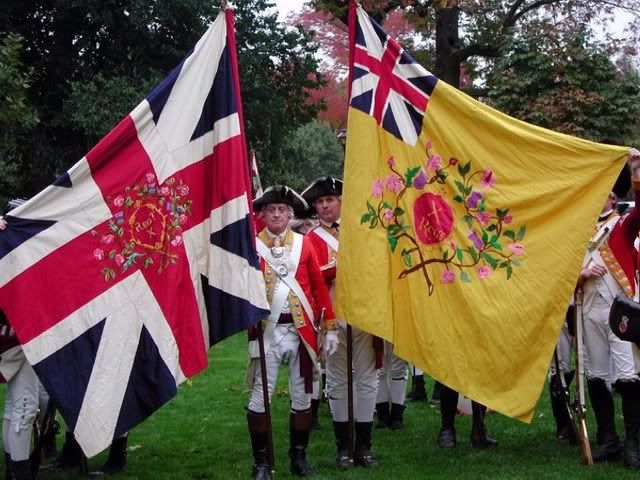
If you should happen across them, call the police, or the 10th Regiment of Foot.
Well, that bit of really upsetting news aside, I am having a grand old time scrolling through this blog, which I believe is run by a current member of the 5th Regiment of Foot.
If you are interested in Colonial Boston, pay it a visit.
Why didn't I think of that?
Well, I have enough online activities as it is, with Recta Ratio, Two Hearts Ablaze, and the 6 Recta Ratio Yahoo Groups, plus 4 Redcoats Yahoo Groups.
This blog is a real treat, with tons of tidbits, as I scroll through.
The "John Howe" spy story has been proven a fake. Follow the link.
Christmas Anticks in Boston.
I found out the 10th Regiment's Colours were stolen out of a car back in March. No word on whether they have been found. This one really gets the blood worked up. I and everyone else in the Regiment sweated blood for those Colours back in the mid-90s. Here is what they look like:

If you should happen across them, call the police, or the 10th Regiment of Foot.
Well, that bit of really upsetting news aside, I am having a grand old time scrolling through this blog, which I believe is run by a current member of the 5th Regiment of Foot.
If you are interested in Colonial Boston, pay it a visit.
Fun On A Rainy Patriots' Day

I came across a site featuring painted plastic toy soldiers (no lead figures that I can see) depicting American Revolution battles. Like me, the collector who put these up is no world-class master figure painter. Charles Stadden has nothing to worry about from either of us.
The link takes you to what I consider the best of 3 pages n the American Revolution. he also has pages on other time periods. You can check out the other pages through his links on the left of his page.
I recognize plastic figures from Accurate, A Call To Arms, Marx (from the old "Sons of Liberty" playset you could buy from the Sears Catalog when I was a kid), and other manufacturers. All are 54mm, or 1/32nd scale, except some older ones I know are 60mm, but they are so close that they just look like unusually tall guys. His painting style is very similar to my own. He uses matte finish acrylics, like the old paints available through Imrie/Risley, and other, newer ones I don't know.
He also converts figures minimally, as I do. I have seen in a book about military miniatures how you can re-sculpt a four-figure diorama of Custer's Last Stand from 4 identical single lead figures of a British cavalryman, pre-WW I. But I am content switching heads and weapons around, maybe the occasional arm; no stripping of the figure and rebuilding him, to make little Frankensoldiers.
Based on the work I have done with American Revolution figures, if I could make a few suggestions to the guy who did this good work, the first would be to look very closely at the Barzso line of products. I see he has used some, but there is more available that will help him out. More plastic 1/32nd scale figures that would work, especially the British Infantry (strip off the packs with an X-Acto, and repaint them as American militia), colonial militia, and highlanders.
Next, there are lead figures from Imrie/Risley, Britain's, Conte Collectibles, and King and Country that would work nicely with his 1/32nd scale plastic. Of course lead is more expensive. A single Imre/Risley unpainted lead figure costs $10.00 or more. For that price, you can get 20 plastic figures from Accurate. And you still have to epoxy on the arms and weapon, and paint.
Trees: Lemax, makers of Christmas and Halloween villages, have accessories that will work, including a variety of trees.
Really picky stuff: British drummers in Royal regiments did not wear blue coats! Red with yellow lace. To make Marx British Grenadiers work with the better-researched modern figures, you have to use the X-Acto to scrape off the back of the grenadier helmet, leaving a flat surface you can repaint, with black for the fur around the edge, but red for the felt back, in the center.
I know, I just lost everyone except the guy who did the work and myself, and maybe Dale Price and Wansbutter.
But heck, its my blog, and I'll geek out toy-soldierish if I want to!
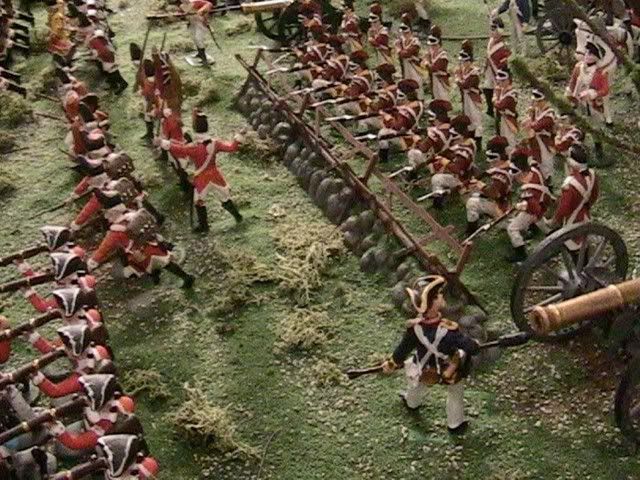
Hock Monday
It almost slipped my mind to note that hocktide begins today. it only lasts today and tomorrow, so don't blink, or you will miss it. It is the end of post-Easter rest from work and festivity, analogous to Plough Monday after Christmas/Epiphany.
The ritual associated with hocktide sounds like a Spring mating ritual to me. On Hock Monday, the unmarried ladies of the parish could stop and bind passing unmarried men, demanding some payment, either monetary or a kiss. If monetary, the ransoms went to the parish funds. On Hock Tuesday, tomorrow, the men had the right to capture unmarried passing women.
The ritual associated with hocktide sounds like a Spring mating ritual to me. On Hock Monday, the unmarried ladies of the parish could stop and bind passing unmarried men, demanding some payment, either monetary or a kiss. If monetary, the ransoms went to the parish funds. On Hock Tuesday, tomorrow, the men had the right to capture unmarried passing women.
Some of Christendom's Most Precious Relics
Rome's Church of the Holy Cross In Jerusalem, a major station church during Lent, is home to some of Christendom's greatest treasures. Our British collegues, especially Mulier Fortis and Father Longenecker have called my attention to these precious relics.
Of course, as with any relics dating from the 1st century AD, authenticity is always a question. But if these things are what they purport to be, and what the faithful have believed them to be for time-out-of-mind, then this place, this relic chapel, ought to be on the itinerary of any pilgrim to Rome.
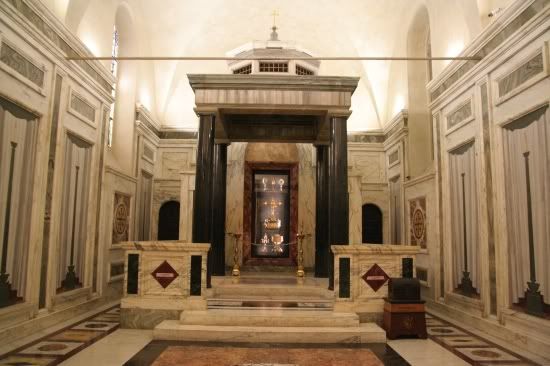
Here is a view of the Relic Chapel

I would say this is the least important of the relics on display: a large fragment of the cross of St. Dismas, the Good Thief.
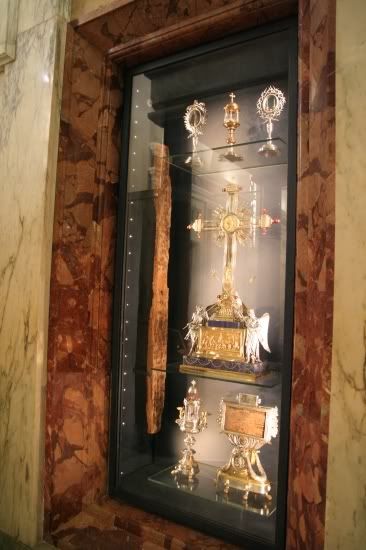
This backs us up a bit, and shows how the reliquaries are arranged in relation to each other.
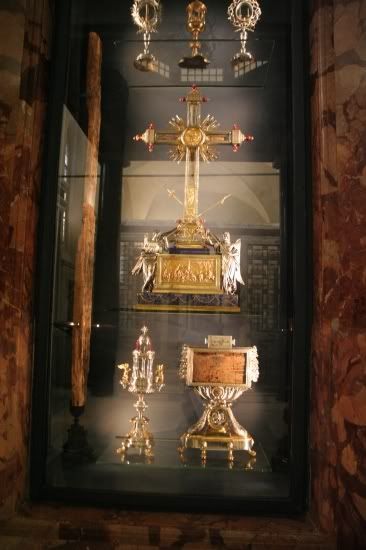
Another view of these treasures
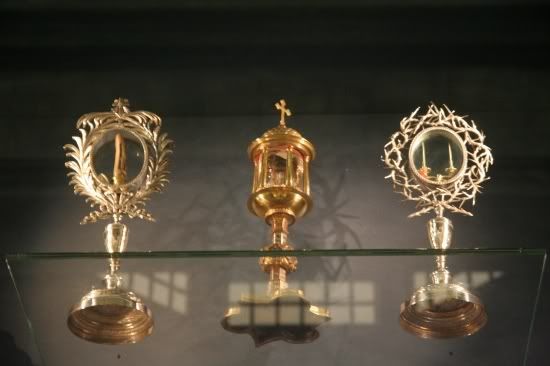
Let's start at the top. There are three reliquaries on this shelf. The one on the left is an index finger, said to be that of St. Thomas. Is this the finger that probed the wounds of the Risen Lord? In the center is a reliquary containing a piece of stone from the pillar against which Our Lord was scourged. On the right, in the Crown of Thorns reliquary, are two fragments of what is thought to be the original Crown of Thorns.
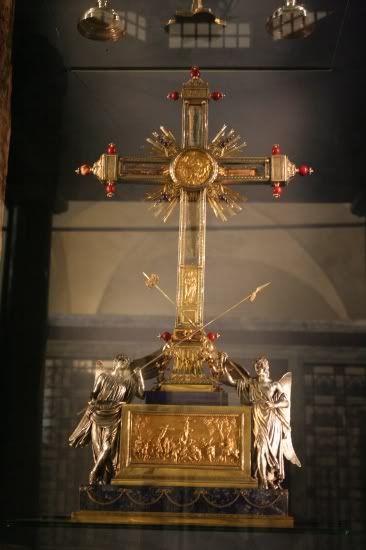
On the middle shelf, in the Cross-shaped reliquary, are three small fragments believed to be fragments of the True Cross itself.
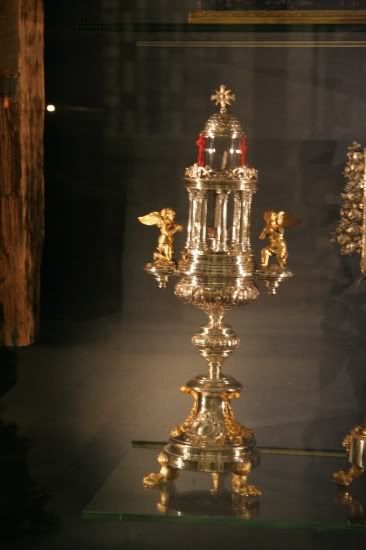
On the bottom shelf to the left, is a reliquary containing what is believed to be a nail used to nail Our Lord to the Cross!

We are not done yet. Bottom shelf, to the right. This is a large portion of what is believe to be the original title that hung above Our Lord's Head on the Cross.
I know. I can hear the objections. Authenticity! Proof! Pious fabrications! Frauds!
But what if these items are what they have been believed to be?
Of course, as with any relics dating from the 1st century AD, authenticity is always a question. But if these things are what they purport to be, and what the faithful have believed them to be for time-out-of-mind, then this place, this relic chapel, ought to be on the itinerary of any pilgrim to Rome.

Here is a view of the Relic Chapel

I would say this is the least important of the relics on display: a large fragment of the cross of St. Dismas, the Good Thief.

This backs us up a bit, and shows how the reliquaries are arranged in relation to each other.

Another view of these treasures

Let's start at the top. There are three reliquaries on this shelf. The one on the left is an index finger, said to be that of St. Thomas. Is this the finger that probed the wounds of the Risen Lord? In the center is a reliquary containing a piece of stone from the pillar against which Our Lord was scourged. On the right, in the Crown of Thorns reliquary, are two fragments of what is thought to be the original Crown of Thorns.

On the middle shelf, in the Cross-shaped reliquary, are three small fragments believed to be fragments of the True Cross itself.

On the bottom shelf to the left, is a reliquary containing what is believed to be a nail used to nail Our Lord to the Cross!

We are not done yet. Bottom shelf, to the right. This is a large portion of what is believe to be the original title that hung above Our Lord's Head on the Cross.
I know. I can hear the objections. Authenticity! Proof! Pious fabrications! Frauds!
But what if these items are what they have been believed to be?


